Cardiovascular Disease in Older Greek Adults and Cognitive Impairment
VerifiedAdded on 2023/03/17
|24
|6449
|49
AI Summary
This study aims to determine the impact of cardiovascular disease on cognitive functions in older Greek adults. The sample size is thirty (30) Greek elderly adults, with fifteen (15) unhealthy and fifteen (15) healthy participants. Cognitive tests will be conducted to assess memory, visual abilities, and other cognitive functions. The findings will provide insights into the connection between cognitive variables and cardiovascular disease in elderly patients.
Contribute Materials
Your contribution can guide someone’s learning journey. Share your
documents today.
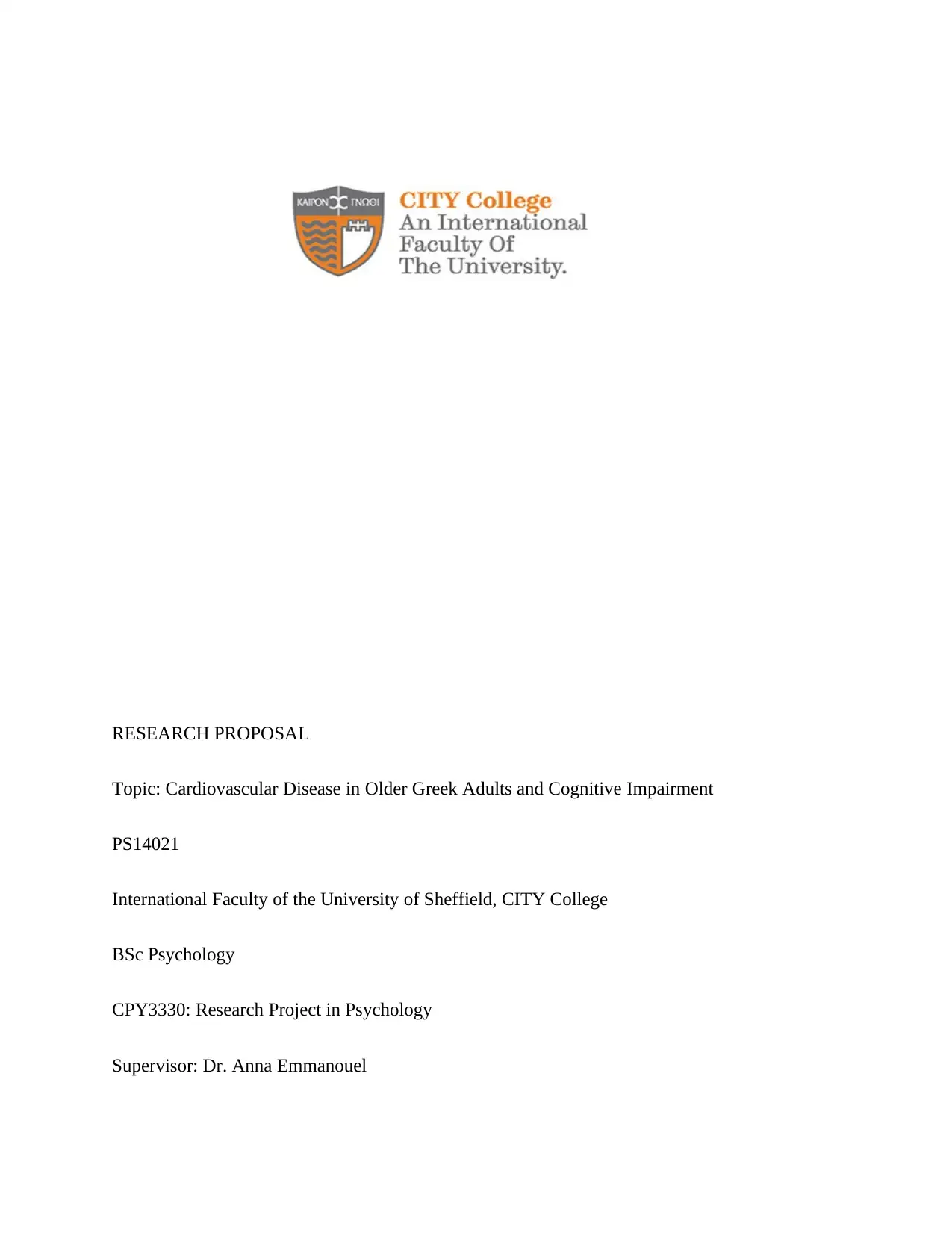
RESEARCH PROPOSAL
Topic: Cardiovascular Disease in Older Greek Adults and Cognitive Impairment
PS14021
International Faculty of the University of Sheffield, CITY College
BSc Psychology
CPY3330: Research Project in Psychology
Supervisor: Dr. Anna Emmanouel
Topic: Cardiovascular Disease in Older Greek Adults and Cognitive Impairment
PS14021
International Faculty of the University of Sheffield, CITY College
BSc Psychology
CPY3330: Research Project in Psychology
Supervisor: Dr. Anna Emmanouel
Secure Best Marks with AI Grader
Need help grading? Try our AI Grader for instant feedback on your assignments.
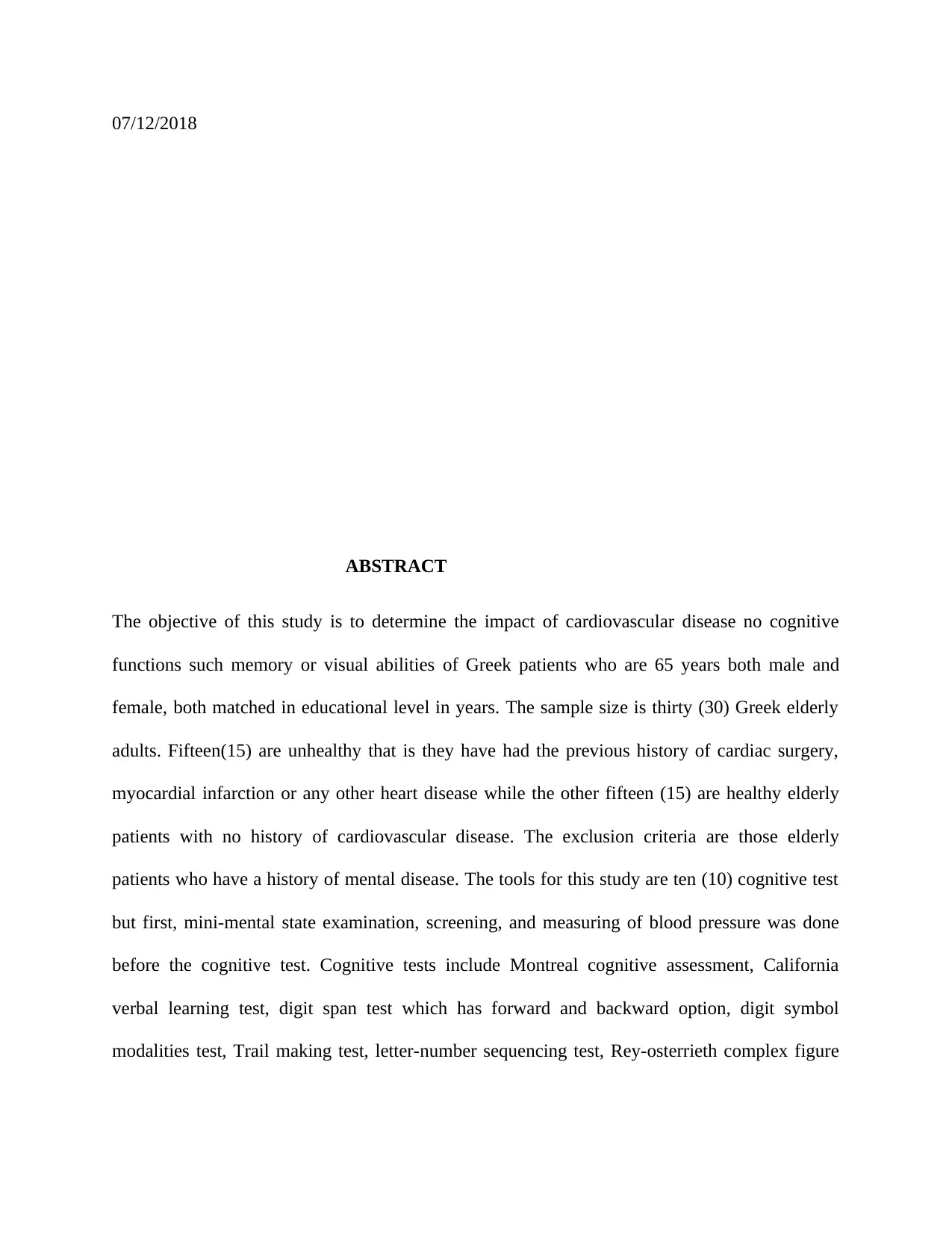
07/12/2018
ABSTRACT
The objective of this study is to determine the impact of cardiovascular disease no cognitive
functions such memory or visual abilities of Greek patients who are 65 years both male and
female, both matched in educational level in years. The sample size is thirty (30) Greek elderly
adults. Fifteen(15) are unhealthy that is they have had the previous history of cardiac surgery,
myocardial infarction or any other heart disease while the other fifteen (15) are healthy elderly
patients with no history of cardiovascular disease. The exclusion criteria are those elderly
patients who have a history of mental disease. The tools for this study are ten (10) cognitive test
but first, mini-mental state examination, screening, and measuring of blood pressure was done
before the cognitive test. Cognitive tests include Montreal cognitive assessment, California
verbal learning test, digit span test which has forward and backward option, digit symbol
modalities test, Trail making test, letter-number sequencing test, Rey-osterrieth complex figure
ABSTRACT
The objective of this study is to determine the impact of cardiovascular disease no cognitive
functions such memory or visual abilities of Greek patients who are 65 years both male and
female, both matched in educational level in years. The sample size is thirty (30) Greek elderly
adults. Fifteen(15) are unhealthy that is they have had the previous history of cardiac surgery,
myocardial infarction or any other heart disease while the other fifteen (15) are healthy elderly
patients with no history of cardiovascular disease. The exclusion criteria are those elderly
patients who have a history of mental disease. The tools for this study are ten (10) cognitive test
but first, mini-mental state examination, screening, and measuring of blood pressure was done
before the cognitive test. Cognitive tests include Montreal cognitive assessment, California
verbal learning test, digit span test which has forward and backward option, digit symbol
modalities test, Trail making test, letter-number sequencing test, Rey-osterrieth complex figure
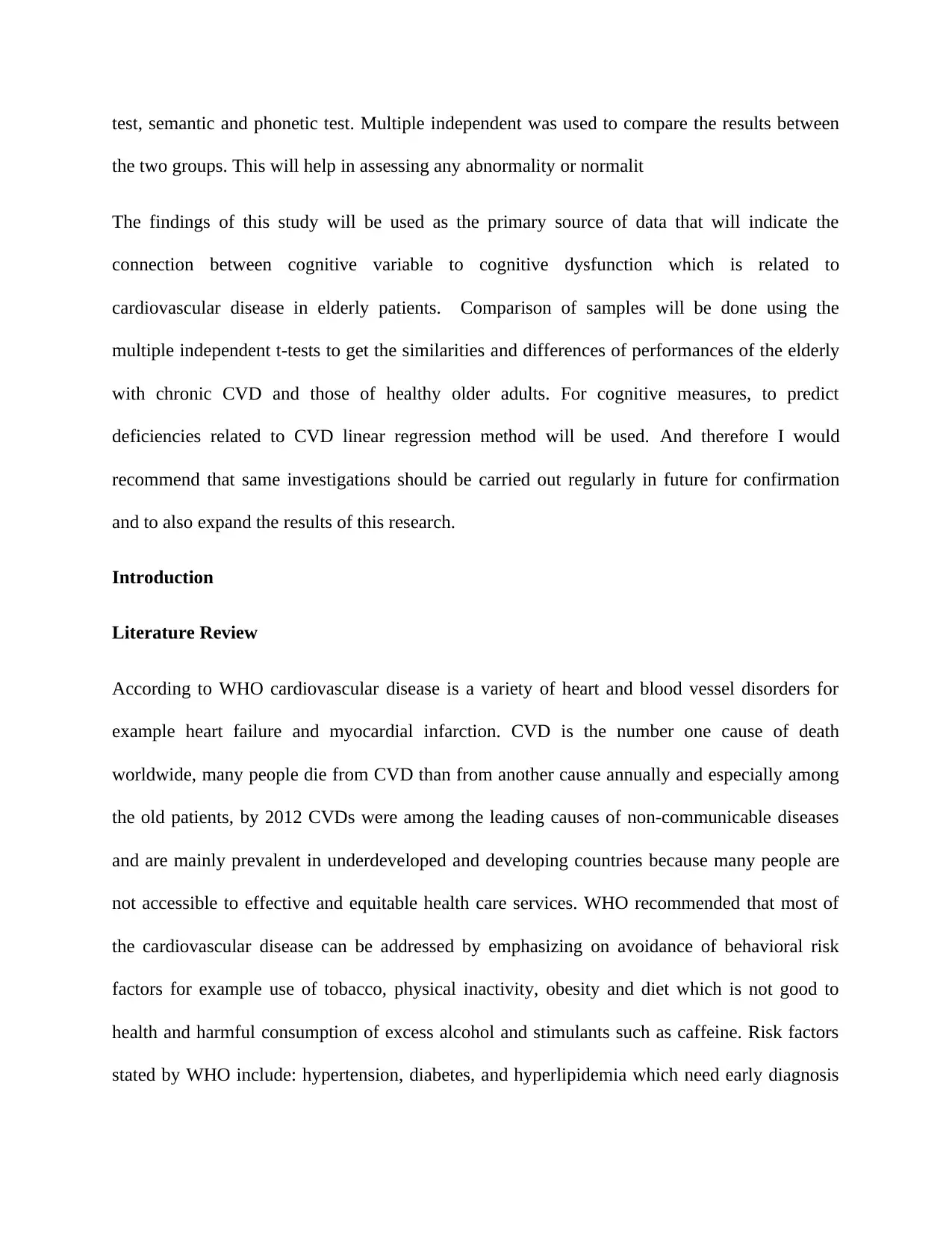
test, semantic and phonetic test. Multiple independent was used to compare the results between
the two groups. This will help in assessing any abnormality or normalit
The findings of this study will be used as the primary source of data that will indicate the
connection between cognitive variable to cognitive dysfunction which is related to
cardiovascular disease in elderly patients. Comparison of samples will be done using the
multiple independent t-tests to get the similarities and differences of performances of the elderly
with chronic CVD and those of healthy older adults. For cognitive measures, to predict
deficiencies related to CVD linear regression method will be used. And therefore I would
recommend that same investigations should be carried out regularly in future for confirmation
and to also expand the results of this research.
Introduction
Literature Review
According to WHO cardiovascular disease is a variety of heart and blood vessel disorders for
example heart failure and myocardial infarction. CVD is the number one cause of death
worldwide, many people die from CVD than from another cause annually and especially among
the old patients, by 2012 CVDs were among the leading causes of non-communicable diseases
and are mainly prevalent in underdeveloped and developing countries because many people are
not accessible to effective and equitable health care services. WHO recommended that most of
the cardiovascular disease can be addressed by emphasizing on avoidance of behavioral risk
factors for example use of tobacco, physical inactivity, obesity and diet which is not good to
health and harmful consumption of excess alcohol and stimulants such as caffeine. Risk factors
stated by WHO include: hypertension, diabetes, and hyperlipidemia which need early diagnosis
the two groups. This will help in assessing any abnormality or normalit
The findings of this study will be used as the primary source of data that will indicate the
connection between cognitive variable to cognitive dysfunction which is related to
cardiovascular disease in elderly patients. Comparison of samples will be done using the
multiple independent t-tests to get the similarities and differences of performances of the elderly
with chronic CVD and those of healthy older adults. For cognitive measures, to predict
deficiencies related to CVD linear regression method will be used. And therefore I would
recommend that same investigations should be carried out regularly in future for confirmation
and to also expand the results of this research.
Introduction
Literature Review
According to WHO cardiovascular disease is a variety of heart and blood vessel disorders for
example heart failure and myocardial infarction. CVD is the number one cause of death
worldwide, many people die from CVD than from another cause annually and especially among
the old patients, by 2012 CVDs were among the leading causes of non-communicable diseases
and are mainly prevalent in underdeveloped and developing countries because many people are
not accessible to effective and equitable health care services. WHO recommended that most of
the cardiovascular disease can be addressed by emphasizing on avoidance of behavioral risk
factors for example use of tobacco, physical inactivity, obesity and diet which is not good to
health and harmful consumption of excess alcohol and stimulants such as caffeine. Risk factors
stated by WHO include: hypertension, diabetes, and hyperlipidemia which need early diagnosis

and management using appropriate drugs and counseling therapy. WHO was able to put the
mechanism in place to reduce the avoidable disease burdens by implementing a global action
plan for prevention and control of NCDs 2013-2020 and the sixth target is reduction of blood
pressure which the main contributing factor to cardiovascular disease and the eighth target is to
implement the use of drugs and guiding counseling on stress to prevent attacks and strokes
In Greece, 38% of the mortality rate has been due to CVD mainly caused by ischemic attacks,
more than17.5 million deaths are from CVD and are associated with risk factors which are
modifiable and can be controlled such as hypertension, diabetes, and obesity, increasing rate of
depression has made it even worse (Lim et al., 2012). Hazzouri et al. (2014) found an important
connection between cognitive impairment and CVD risk factors in elderly people, incidences of
CVD risk factors increase with age and they are considered the source of cognitive changes that
are thought to be part of the aging process which is actually not but rather cognitive impairment
due to cardiovascular disease, it is important to consider these factors and to recommend them
more routine cognitive screening because this will lead to early diagnosis and management of
risk for example hypertension.
Loss of memory and dementia are among the disorders that old people suffer from and CVD is a
secondary cause of these disorders. Gikas et al. (2016) also show a strong relationship between
severe cognitive decline and CVD in the elderly that it is the most frequent as aging causes the
heart and its blood vessels to stiffen which can lead to cardiovascular disease. CVD functions
and noted the association between high obesity, diabetes, and blood pressure with cognition of
human's brain (Leritz et al, 2011). These three conditions have been associated with both
cardiovascular disease and dementia and a decrease in cognit ive function. Diabetes particularly
mechanism in place to reduce the avoidable disease burdens by implementing a global action
plan for prevention and control of NCDs 2013-2020 and the sixth target is reduction of blood
pressure which the main contributing factor to cardiovascular disease and the eighth target is to
implement the use of drugs and guiding counseling on stress to prevent attacks and strokes
In Greece, 38% of the mortality rate has been due to CVD mainly caused by ischemic attacks,
more than17.5 million deaths are from CVD and are associated with risk factors which are
modifiable and can be controlled such as hypertension, diabetes, and obesity, increasing rate of
depression has made it even worse (Lim et al., 2012). Hazzouri et al. (2014) found an important
connection between cognitive impairment and CVD risk factors in elderly people, incidences of
CVD risk factors increase with age and they are considered the source of cognitive changes that
are thought to be part of the aging process which is actually not but rather cognitive impairment
due to cardiovascular disease, it is important to consider these factors and to recommend them
more routine cognitive screening because this will lead to early diagnosis and management of
risk for example hypertension.
Loss of memory and dementia are among the disorders that old people suffer from and CVD is a
secondary cause of these disorders. Gikas et al. (2016) also show a strong relationship between
severe cognitive decline and CVD in the elderly that it is the most frequent as aging causes the
heart and its blood vessels to stiffen which can lead to cardiovascular disease. CVD functions
and noted the association between high obesity, diabetes, and blood pressure with cognition of
human's brain (Leritz et al, 2011). These three conditions have been associated with both
cardiovascular disease and dementia and a decrease in cognit ive function. Diabetes particularly
Secure Best Marks with AI Grader
Need help grading? Try our AI Grader for instant feedback on your assignments.
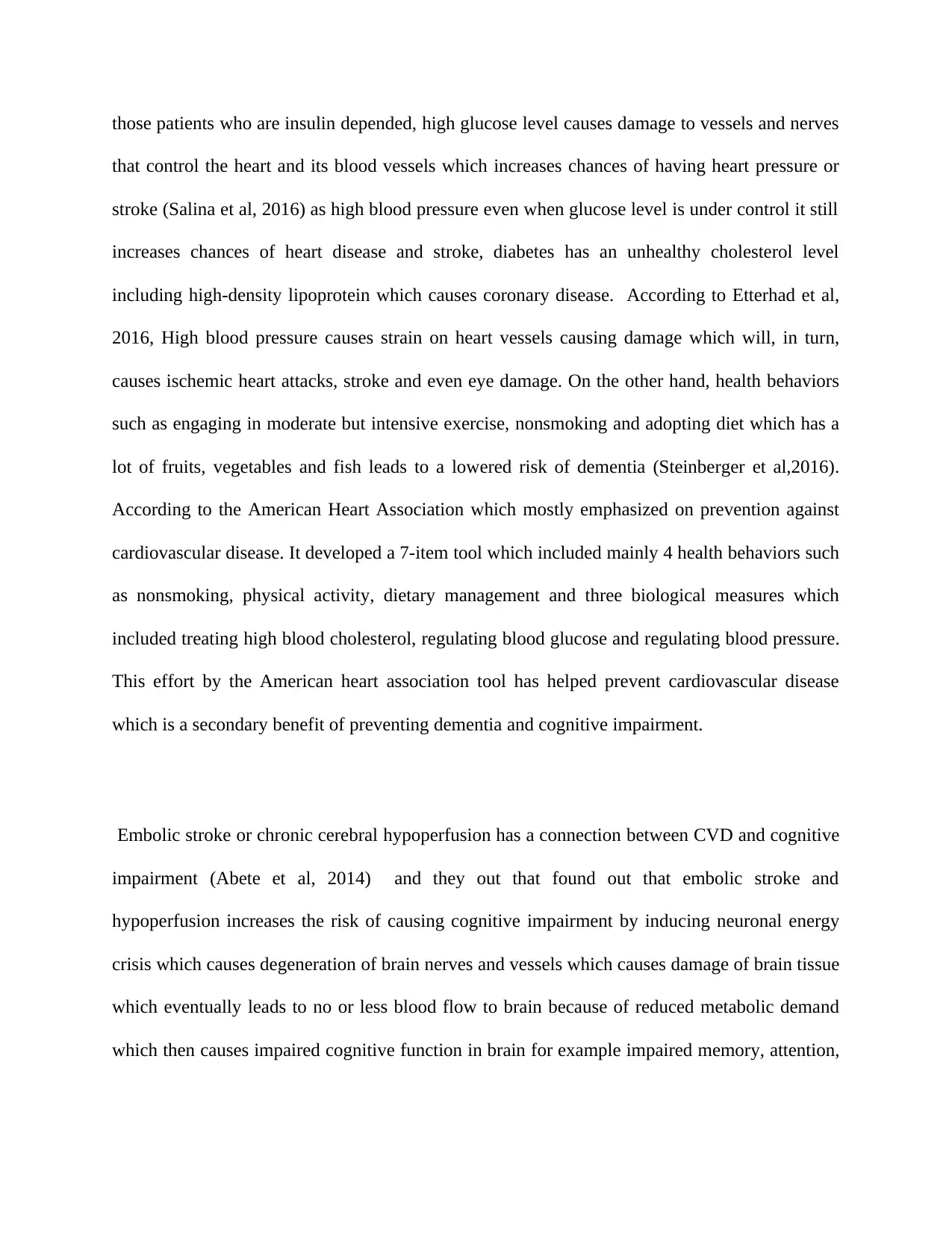
those patients who are insulin depended, high glucose level causes damage to vessels and nerves
that control the heart and its blood vessels which increases chances of having heart pressure or
stroke (Salina et al, 2016) as high blood pressure even when glucose level is under control it still
increases chances of heart disease and stroke, diabetes has an unhealthy cholesterol level
including high-density lipoprotein which causes coronary disease. According to Etterhad et al,
2016, High blood pressure causes strain on heart vessels causing damage which will, in turn,
causes ischemic heart attacks, stroke and even eye damage. On the other hand, health behaviors
such as engaging in moderate but intensive exercise, nonsmoking and adopting diet which has a
lot of fruits, vegetables and fish leads to a lowered risk of dementia (Steinberger et al,2016).
According to the American Heart Association which mostly emphasized on prevention against
cardiovascular disease. It developed a 7-item tool which included mainly 4 health behaviors such
as nonsmoking, physical activity, dietary management and three biological measures which
included treating high blood cholesterol, regulating blood glucose and regulating blood pressure.
This effort by the American heart association tool has helped prevent cardiovascular disease
which is a secondary benefit of preventing dementia and cognitive impairment.
Embolic stroke or chronic cerebral hypoperfusion has a connection between CVD and cognitive
impairment (Abete et al, 2014) and they out that found out that embolic stroke and
hypoperfusion increases the risk of causing cognitive impairment by inducing neuronal energy
crisis which causes degeneration of brain nerves and vessels which causes damage of brain tissue
which eventually leads to no or less blood flow to brain because of reduced metabolic demand
which then causes impaired cognitive function in brain for example impaired memory, attention,
that control the heart and its blood vessels which increases chances of having heart pressure or
stroke (Salina et al, 2016) as high blood pressure even when glucose level is under control it still
increases chances of heart disease and stroke, diabetes has an unhealthy cholesterol level
including high-density lipoprotein which causes coronary disease. According to Etterhad et al,
2016, High blood pressure causes strain on heart vessels causing damage which will, in turn,
causes ischemic heart attacks, stroke and even eye damage. On the other hand, health behaviors
such as engaging in moderate but intensive exercise, nonsmoking and adopting diet which has a
lot of fruits, vegetables and fish leads to a lowered risk of dementia (Steinberger et al,2016).
According to the American Heart Association which mostly emphasized on prevention against
cardiovascular disease. It developed a 7-item tool which included mainly 4 health behaviors such
as nonsmoking, physical activity, dietary management and three biological measures which
included treating high blood cholesterol, regulating blood glucose and regulating blood pressure.
This effort by the American heart association tool has helped prevent cardiovascular disease
which is a secondary benefit of preventing dementia and cognitive impairment.
Embolic stroke or chronic cerebral hypoperfusion has a connection between CVD and cognitive
impairment (Abete et al, 2014) and they out that found out that embolic stroke and
hypoperfusion increases the risk of causing cognitive impairment by inducing neuronal energy
crisis which causes degeneration of brain nerves and vessels which causes damage of brain tissue
which eventually leads to no or less blood flow to brain because of reduced metabolic demand
which then causes impaired cognitive function in brain for example impaired memory, attention,
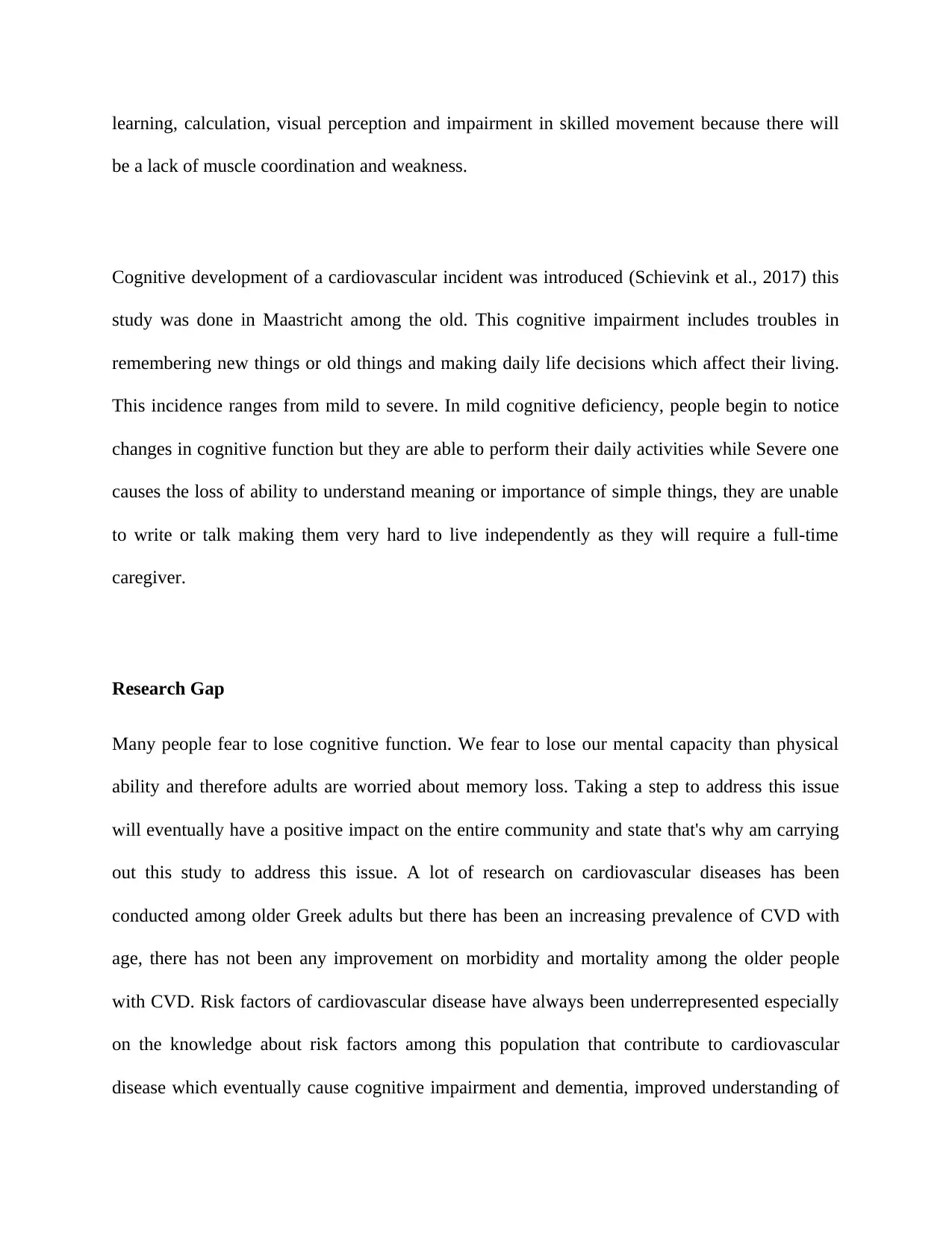
learning, calculation, visual perception and impairment in skilled movement because there will
be a lack of muscle coordination and weakness.
Cognitive development of a cardiovascular incident was introduced (Schievink et al., 2017) this
study was done in Maastricht among the old. This cognitive impairment includes troubles in
remembering new things or old things and making daily life decisions which affect their living.
This incidence ranges from mild to severe. In mild cognitive deficiency, people begin to notice
changes in cognitive function but they are able to perform their daily activities while Severe one
causes the loss of ability to understand meaning or importance of simple things, they are unable
to write or talk making them very hard to live independently as they will require a full-time
caregiver.
Research Gap
Many people fear to lose cognitive function. We fear to lose our mental capacity than physical
ability and therefore adults are worried about memory loss. Taking a step to address this issue
will eventually have a positive impact on the entire community and state that's why am carrying
out this study to address this issue. A lot of research on cardiovascular diseases has been
conducted among older Greek adults but there has been an increasing prevalence of CVD with
age, there has not been any improvement on morbidity and mortality among the older people
with CVD. Risk factors of cardiovascular disease have always been underrepresented especially
on the knowledge about risk factors among this population that contribute to cardiovascular
disease which eventually cause cognitive impairment and dementia, improved understanding of
be a lack of muscle coordination and weakness.
Cognitive development of a cardiovascular incident was introduced (Schievink et al., 2017) this
study was done in Maastricht among the old. This cognitive impairment includes troubles in
remembering new things or old things and making daily life decisions which affect their living.
This incidence ranges from mild to severe. In mild cognitive deficiency, people begin to notice
changes in cognitive function but they are able to perform their daily activities while Severe one
causes the loss of ability to understand meaning or importance of simple things, they are unable
to write or talk making them very hard to live independently as they will require a full-time
caregiver.
Research Gap
Many people fear to lose cognitive function. We fear to lose our mental capacity than physical
ability and therefore adults are worried about memory loss. Taking a step to address this issue
will eventually have a positive impact on the entire community and state that's why am carrying
out this study to address this issue. A lot of research on cardiovascular diseases has been
conducted among older Greek adults but there has been an increasing prevalence of CVD with
age, there has not been any improvement on morbidity and mortality among the older people
with CVD. Risk factors of cardiovascular disease have always been underrepresented especially
on the knowledge about risk factors among this population that contribute to cardiovascular
disease which eventually cause cognitive impairment and dementia, improved understanding of
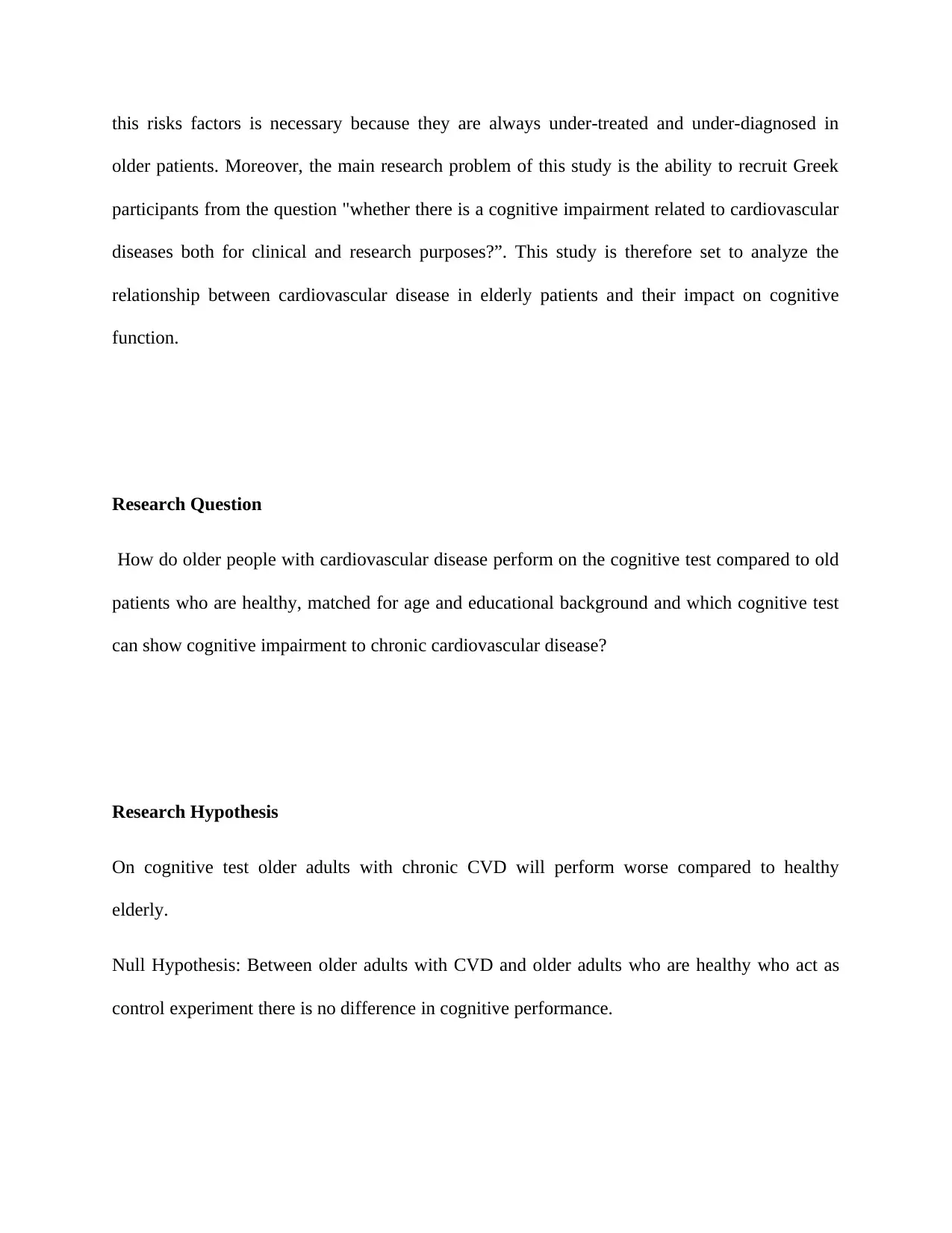
this risks factors is necessary because they are always under-treated and under-diagnosed in
older patients. Moreover, the main research problem of this study is the ability to recruit Greek
participants from the question "whether there is a cognitive impairment related to cardiovascular
diseases both for clinical and research purposes?”. This study is therefore set to analyze the
relationship between cardiovascular disease in elderly patients and their impact on cognitive
function.
Research Question
How do older people with cardiovascular disease perform on the cognitive test compared to old
patients who are healthy, matched for age and educational background and which cognitive test
can show cognitive impairment to chronic cardiovascular disease?
Research Hypothesis
On cognitive test older adults with chronic CVD will perform worse compared to healthy
elderly.
Null Hypothesis: Between older adults with CVD and older adults who are healthy who act as
control experiment there is no difference in cognitive performance.
older patients. Moreover, the main research problem of this study is the ability to recruit Greek
participants from the question "whether there is a cognitive impairment related to cardiovascular
diseases both for clinical and research purposes?”. This study is therefore set to analyze the
relationship between cardiovascular disease in elderly patients and their impact on cognitive
function.
Research Question
How do older people with cardiovascular disease perform on the cognitive test compared to old
patients who are healthy, matched for age and educational background and which cognitive test
can show cognitive impairment to chronic cardiovascular disease?
Research Hypothesis
On cognitive test older adults with chronic CVD will perform worse compared to healthy
elderly.
Null Hypothesis: Between older adults with CVD and older adults who are healthy who act as
control experiment there is no difference in cognitive performance.
Paraphrase This Document
Need a fresh take? Get an instant paraphrase of this document with our AI Paraphraser

Methodology
Participants
Eligible participants for this study will be 30 individuals in total. They should be of both sexes
matched with educational level in years and of 65years and above. They will be grouped into two
groups according to the status of their health. The first group consists of fifteen (15) with CVD
and the other fifteen (15) are healthy. According to (Bastien et al. (2014) he suggested that
participants will be included in the study if they have had one or more of heart conditions such as
cardiac surgery or myocardial infarction. individuals with a psychiatric disease such as
schizophrenia, dementia or neurodegenerative disorders and they are using psychoactive drugs
will be excluded from the study.
All participants are required to provide their consent so that they will be allowed to participate in
this study. Before distributing the questionnaires, participants will be given enough time to read
the consent form and informed sheet and allowed to decide whether they will participate in the
study or not. They are given room for any clarification or questions concerning the study. The
participant has the right to withdraw from carrying out this study at any time if they wish without
giving any explanation to the researcher why they don’t want to take part in the study.
Participants who participate voluntarily are to sign the written consent form and will be included
in the study. In the consent form, they ensure their acknowledgment of the important process and
the objective as well as their voluntary, anonymous participation and the collection of the data
for research purposes. Confidential information such as Personal information, medical records
should not be disclosed. Results of the participants will also remain confidential since their
Participants
Eligible participants for this study will be 30 individuals in total. They should be of both sexes
matched with educational level in years and of 65years and above. They will be grouped into two
groups according to the status of their health. The first group consists of fifteen (15) with CVD
and the other fifteen (15) are healthy. According to (Bastien et al. (2014) he suggested that
participants will be included in the study if they have had one or more of heart conditions such as
cardiac surgery or myocardial infarction. individuals with a psychiatric disease such as
schizophrenia, dementia or neurodegenerative disorders and they are using psychoactive drugs
will be excluded from the study.
All participants are required to provide their consent so that they will be allowed to participate in
this study. Before distributing the questionnaires, participants will be given enough time to read
the consent form and informed sheet and allowed to decide whether they will participate in the
study or not. They are given room for any clarification or questions concerning the study. The
participant has the right to withdraw from carrying out this study at any time if they wish without
giving any explanation to the researcher why they don’t want to take part in the study.
Participants who participate voluntarily are to sign the written consent form and will be included
in the study. In the consent form, they ensure their acknowledgment of the important process and
the objective as well as their voluntary, anonymous participation and the collection of the data
for research purposes. Confidential information such as Personal information, medical records
should not be disclosed. Results of the participants will also remain confidential since their
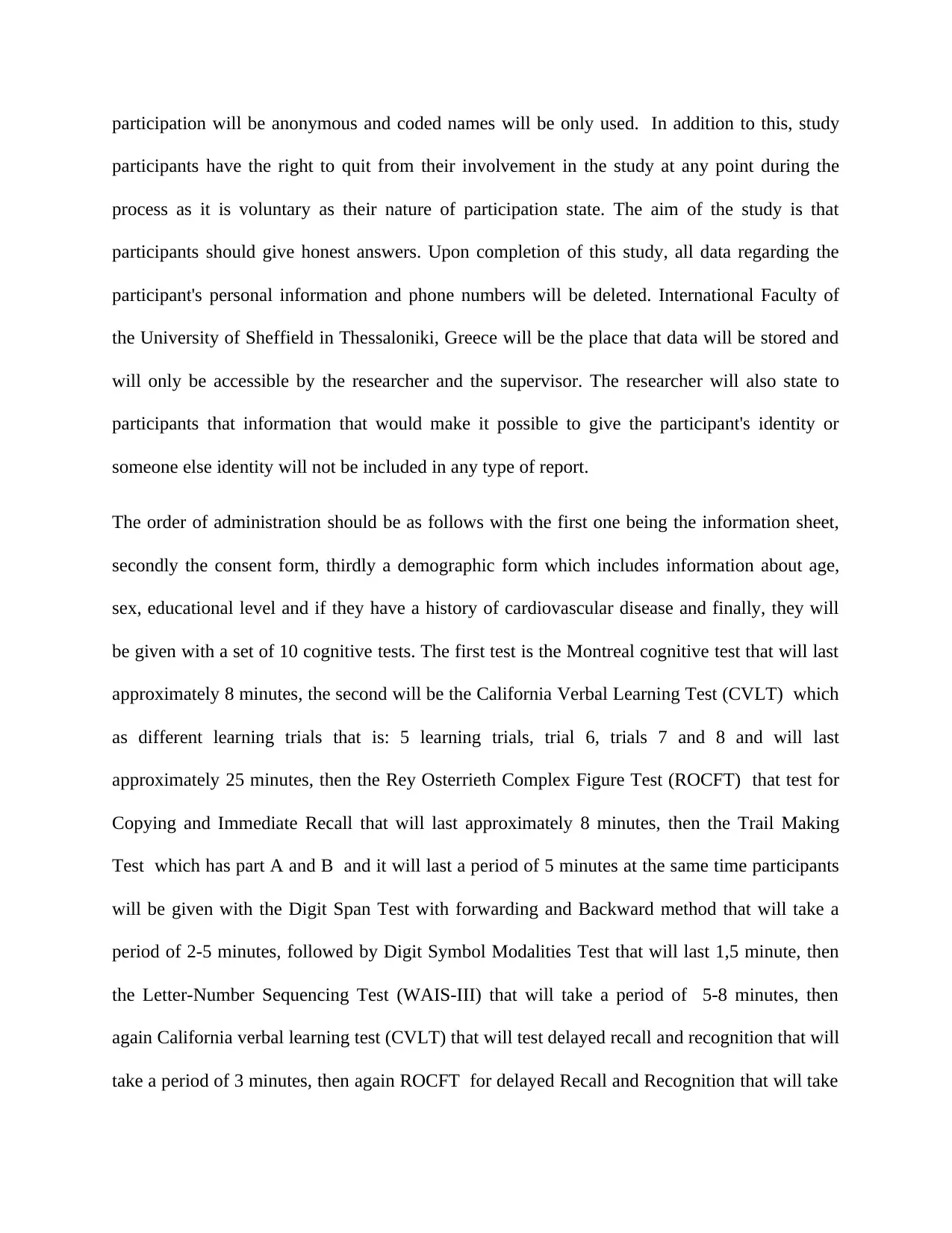
participation will be anonymous and coded names will be only used. In addition to this, study
participants have the right to quit from their involvement in the study at any point during the
process as it is voluntary as their nature of participation state. The aim of the study is that
participants should give honest answers. Upon completion of this study, all data regarding the
participant's personal information and phone numbers will be deleted. International Faculty of
the University of Sheffield in Thessaloniki, Greece will be the place that data will be stored and
will only be accessible by the researcher and the supervisor. The researcher will also state to
participants that information that would make it possible to give the participant's identity or
someone else identity will not be included in any type of report.
The order of administration should be as follows with the first one being the information sheet,
secondly the consent form, thirdly a demographic form which includes information about age,
sex, educational level and if they have a history of cardiovascular disease and finally, they will
be given with a set of 10 cognitive tests. The first test is the Montreal cognitive test that will last
approximately 8 minutes, the second will be the California Verbal Learning Test (CVLT) which
as different learning trials that is: 5 learning trials, trial 6, trials 7 and 8 and will last
approximately 25 minutes, then the Rey Osterrieth Complex Figure Test (ROCFT) that test for
Copying and Immediate Recall that will last approximately 8 minutes, then the Trail Making
Test which has part A and B and it will last a period of 5 minutes at the same time participants
will be given with the Digit Span Test with forwarding and Backward method that will take a
period of 2-5 minutes, followed by Digit Symbol Modalities Test that will last 1,5 minute, then
the Letter-Number Sequencing Test (WAIS-III) that will take a period of 5-8 minutes, then
again California verbal learning test (CVLT) that will test delayed recall and recognition that will
take a period of 3 minutes, then again ROCFT for delayed Recall and Recognition that will take
participants have the right to quit from their involvement in the study at any point during the
process as it is voluntary as their nature of participation state. The aim of the study is that
participants should give honest answers. Upon completion of this study, all data regarding the
participant's personal information and phone numbers will be deleted. International Faculty of
the University of Sheffield in Thessaloniki, Greece will be the place that data will be stored and
will only be accessible by the researcher and the supervisor. The researcher will also state to
participants that information that would make it possible to give the participant's identity or
someone else identity will not be included in any type of report.
The order of administration should be as follows with the first one being the information sheet,
secondly the consent form, thirdly a demographic form which includes information about age,
sex, educational level and if they have a history of cardiovascular disease and finally, they will
be given with a set of 10 cognitive tests. The first test is the Montreal cognitive test that will last
approximately 8 minutes, the second will be the California Verbal Learning Test (CVLT) which
as different learning trials that is: 5 learning trials, trial 6, trials 7 and 8 and will last
approximately 25 minutes, then the Rey Osterrieth Complex Figure Test (ROCFT) that test for
Copying and Immediate Recall that will last approximately 8 minutes, then the Trail Making
Test which has part A and B and it will last a period of 5 minutes at the same time participants
will be given with the Digit Span Test with forwarding and Backward method that will take a
period of 2-5 minutes, followed by Digit Symbol Modalities Test that will last 1,5 minute, then
the Letter-Number Sequencing Test (WAIS-III) that will take a period of 5-8 minutes, then
again California verbal learning test (CVLT) that will test delayed recall and recognition that will
take a period of 3 minutes, then again ROCFT for delayed Recall and Recognition that will take

a period of 3 minutes and lastly the speech Fluency Test (Semantic and Phonemic Parts) that will
last 6 minutes.
Measures
Participants will be administered cognitive tests that are ten (10) in total that asses variety of
cognitive functions such as information processing, attention, visual and verbal, working
memory, executive functions, mental flexibility, and visual-constructional capabilities. Montreal
Cognitive Assessment (MoCA) is the first test to be used and will last approximately 8 minutes.
MoCa test is a 30-point screening task. If one of the health participants scored less than or equal
24 points, they will not take part in the study but they will be referred to a neurologist,
(Cummings‐Vaughn et al, 2014). The second will be the California Verbal Learning Test
(CVLT) which has several learning trials that is: trial5, trial 6, trials 7 and 8 and recognition and
will last approximately 25 minutes. Short-term and long-term verbal, verbal material, recall
encoding, and recognition will be examined through MOCA. Participants are requested to learn
and retrieve a list of words (List A), consisting of 16 words and repeat it 5 times. Each time list
A will be repeated by the researcher. After trial 5 researcher will read a new list to the
participants (List B) and then in trial 7 researcher will ask from participants to group the items
from list A in fruits, clothes, tools, and spices respectively.
In addition, the Rey Osterrieth Complex Figure Test (ROCFT) that test for copying and
Immediate Recall will be administered, it will last approximately 8 minutes. Subjects will be
last 6 minutes.
Measures
Participants will be administered cognitive tests that are ten (10) in total that asses variety of
cognitive functions such as information processing, attention, visual and verbal, working
memory, executive functions, mental flexibility, and visual-constructional capabilities. Montreal
Cognitive Assessment (MoCA) is the first test to be used and will last approximately 8 minutes.
MoCa test is a 30-point screening task. If one of the health participants scored less than or equal
24 points, they will not take part in the study but they will be referred to a neurologist,
(Cummings‐Vaughn et al, 2014). The second will be the California Verbal Learning Test
(CVLT) which has several learning trials that is: trial5, trial 6, trials 7 and 8 and recognition and
will last approximately 25 minutes. Short-term and long-term verbal, verbal material, recall
encoding, and recognition will be examined through MOCA. Participants are requested to learn
and retrieve a list of words (List A), consisting of 16 words and repeat it 5 times. Each time list
A will be repeated by the researcher. After trial 5 researcher will read a new list to the
participants (List B) and then in trial 7 researcher will ask from participants to group the items
from list A in fruits, clothes, tools, and spices respectively.
In addition, the Rey Osterrieth Complex Figure Test (ROCFT) that test for copying and
Immediate Recall will be administered, it will last approximately 8 minutes. Subjects will be
Secure Best Marks with AI Grader
Need help grading? Try our AI Grader for instant feedback on your assignments.
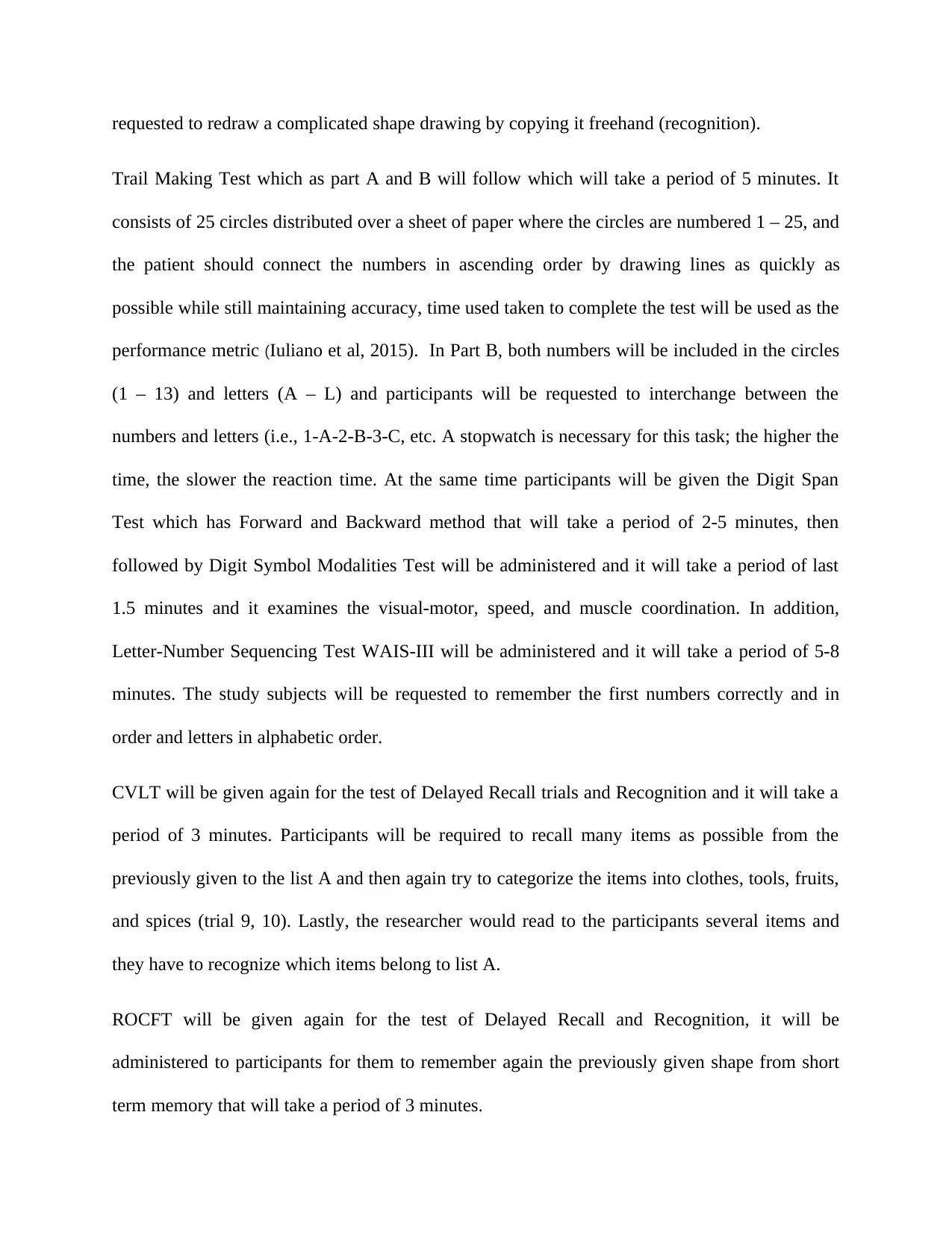
requested to redraw a complicated shape drawing by copying it freehand (recognition).
Trail Making Test which as part A and B will follow which will take a period of 5 minutes. It
consists of 25 circles distributed over a sheet of paper where the circles are numbered 1 – 25, and
the patient should connect the numbers in ascending order by drawing lines as quickly as
possible while still maintaining accuracy, time used taken to complete the test will be used as the
performance metric (Iuliano et al, 2015). In Part B, both numbers will be included in the circles
(1 – 13) and letters (A – L) and participants will be requested to interchange between the
numbers and letters (i.e., 1-A-2-B-3-C, etc. A stopwatch is necessary for this task; the higher the
time, the slower the reaction time. At the same time participants will be given the Digit Span
Test which has Forward and Backward method that will take a period of 2-5 minutes, then
followed by Digit Symbol Modalities Test will be administered and it will take a period of last
1.5 minutes and it examines the visual-motor, speed, and muscle coordination. In addition,
Letter-Number Sequencing Test WAIS-III will be administered and it will take a period of 5-8
minutes. The study subjects will be requested to remember the first numbers correctly and in
order and letters in alphabetic order.
CVLT will be given again for the test of Delayed Recall trials and Recognition and it will take a
period of 3 minutes. Participants will be required to recall many items as possible from the
previously given to the list A and then again try to categorize the items into clothes, tools, fruits,
and spices (trial 9, 10). Lastly, the researcher would read to the participants several items and
they have to recognize which items belong to list A.
ROCFT will be given again for the test of Delayed Recall and Recognition, it will be
administered to participants for them to remember again the previously given shape from short
term memory that will take a period of 3 minutes.
Trail Making Test which as part A and B will follow which will take a period of 5 minutes. It
consists of 25 circles distributed over a sheet of paper where the circles are numbered 1 – 25, and
the patient should connect the numbers in ascending order by drawing lines as quickly as
possible while still maintaining accuracy, time used taken to complete the test will be used as the
performance metric (Iuliano et al, 2015). In Part B, both numbers will be included in the circles
(1 – 13) and letters (A – L) and participants will be requested to interchange between the
numbers and letters (i.e., 1-A-2-B-3-C, etc. A stopwatch is necessary for this task; the higher the
time, the slower the reaction time. At the same time participants will be given the Digit Span
Test which has Forward and Backward method that will take a period of 2-5 minutes, then
followed by Digit Symbol Modalities Test will be administered and it will take a period of last
1.5 minutes and it examines the visual-motor, speed, and muscle coordination. In addition,
Letter-Number Sequencing Test WAIS-III will be administered and it will take a period of 5-8
minutes. The study subjects will be requested to remember the first numbers correctly and in
order and letters in alphabetic order.
CVLT will be given again for the test of Delayed Recall trials and Recognition and it will take a
period of 3 minutes. Participants will be required to recall many items as possible from the
previously given to the list A and then again try to categorize the items into clothes, tools, fruits,
and spices (trial 9, 10). Lastly, the researcher would read to the participants several items and
they have to recognize which items belong to list A.
ROCFT will be given again for the test of Delayed Recall and Recognition, it will be
administered to participants for them to remember again the previously given shape from short
term memory that will take a period of 3 minutes.
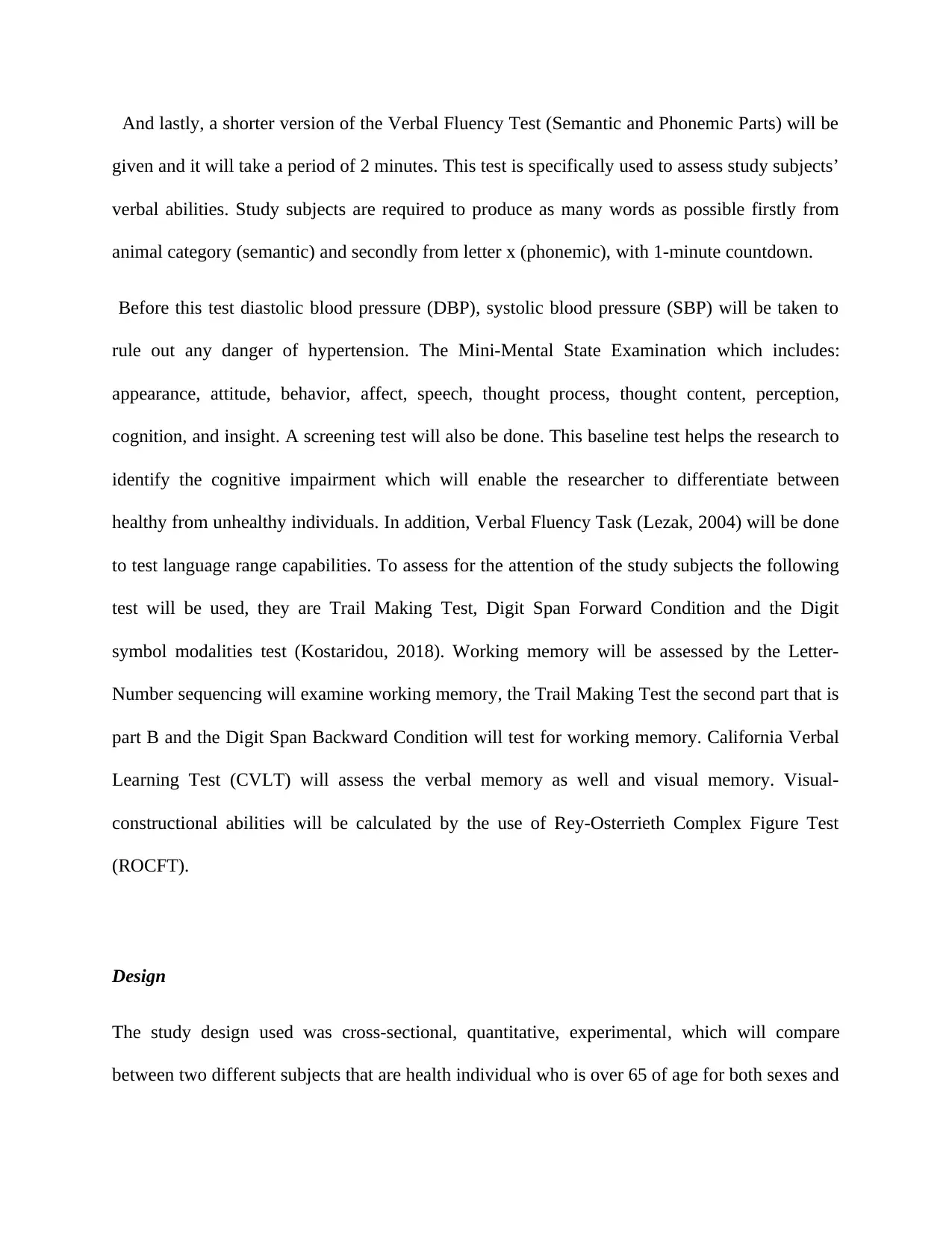
And lastly, a shorter version of the Verbal Fluency Test (Semantic and Phonemic Parts) will be
given and it will take a period of 2 minutes. This test is specifically used to assess study subjects’
verbal abilities. Study subjects are required to produce as many words as possible firstly from
animal category (semantic) and secondly from letter x (phonemic), with 1-minute countdown.
Before this test diastolic blood pressure (DBP), systolic blood pressure (SBP) will be taken to
rule out any danger of hypertension. The Mini-Mental State Examination which includes:
appearance, attitude, behavior, affect, speech, thought process, thought content, perception,
cognition, and insight. A screening test will also be done. This baseline test helps the research to
identify the cognitive impairment which will enable the researcher to differentiate between
healthy from unhealthy individuals. In addition, Verbal Fluency Task (Lezak, 2004) will be done
to test language range capabilities. To assess for the attention of the study subjects the following
test will be used, they are Trail Making Test, Digit Span Forward Condition and the Digit
symbol modalities test (Kostaridou, 2018). Working memory will be assessed by the Letter-
Number sequencing will examine working memory, the Trail Making Test the second part that is
part B and the Digit Span Backward Condition will test for working memory. California Verbal
Learning Test (CVLT) will assess the verbal memory as well and visual memory. Visual-
constructional abilities will be calculated by the use of Rey-Osterrieth Complex Figure Test
(ROCFT).
Design
The study design used was cross-sectional, quantitative, experimental, which will compare
between two different subjects that are health individual who is over 65 of age for both sexes and
given and it will take a period of 2 minutes. This test is specifically used to assess study subjects’
verbal abilities. Study subjects are required to produce as many words as possible firstly from
animal category (semantic) and secondly from letter x (phonemic), with 1-minute countdown.
Before this test diastolic blood pressure (DBP), systolic blood pressure (SBP) will be taken to
rule out any danger of hypertension. The Mini-Mental State Examination which includes:
appearance, attitude, behavior, affect, speech, thought process, thought content, perception,
cognition, and insight. A screening test will also be done. This baseline test helps the research to
identify the cognitive impairment which will enable the researcher to differentiate between
healthy from unhealthy individuals. In addition, Verbal Fluency Task (Lezak, 2004) will be done
to test language range capabilities. To assess for the attention of the study subjects the following
test will be used, they are Trail Making Test, Digit Span Forward Condition and the Digit
symbol modalities test (Kostaridou, 2018). Working memory will be assessed by the Letter-
Number sequencing will examine working memory, the Trail Making Test the second part that is
part B and the Digit Span Backward Condition will test for working memory. California Verbal
Learning Test (CVLT) will assess the verbal memory as well and visual memory. Visual-
constructional abilities will be calculated by the use of Rey-Osterrieth Complex Figure Test
(ROCFT).
Design
The study design used was cross-sectional, quantitative, experimental, which will compare
between two different subjects that are health individual who is over 65 of age for both sexes and
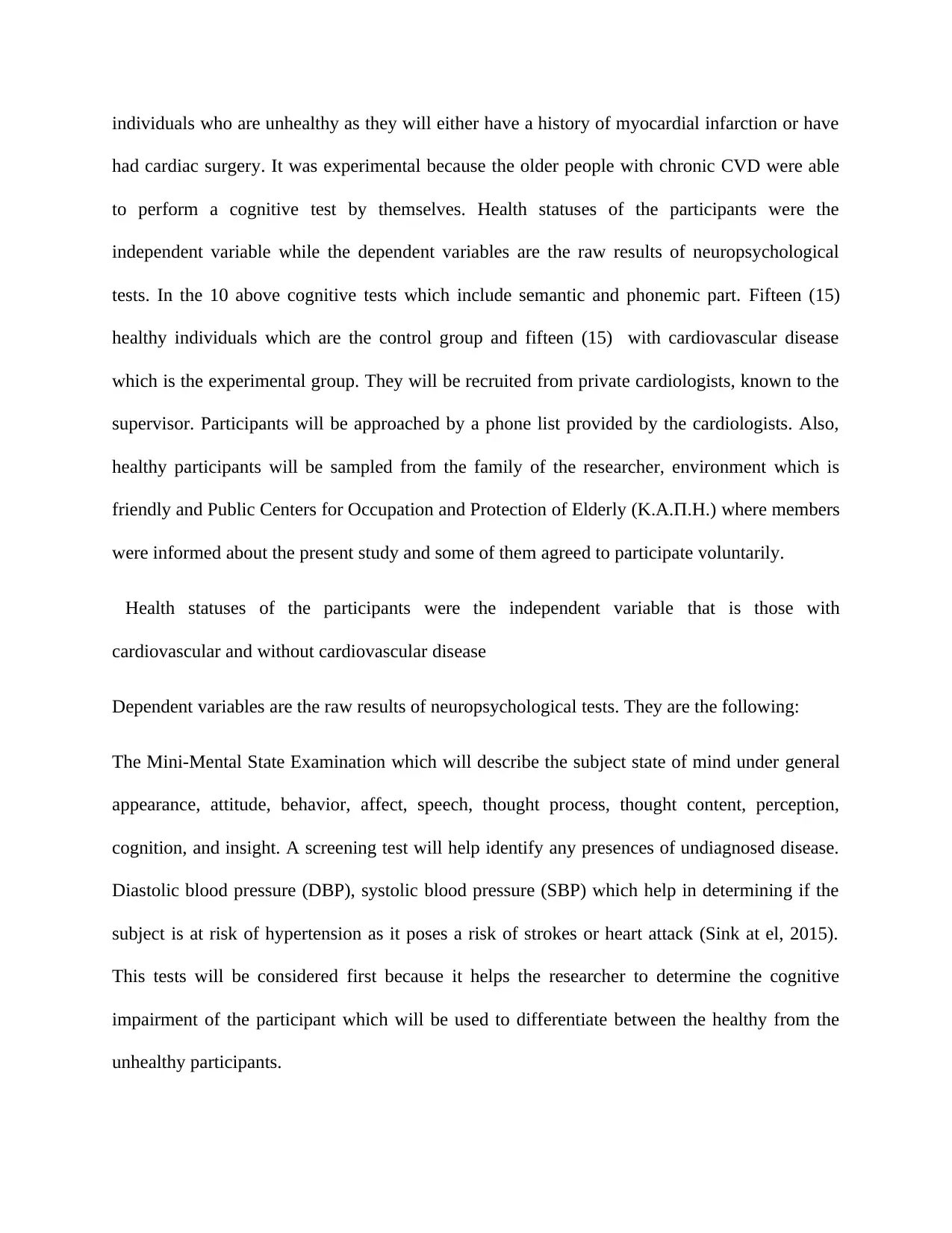
individuals who are unhealthy as they will either have a history of myocardial infarction or have
had cardiac surgery. It was experimental because the older people with chronic CVD were able
to perform a cognitive test by themselves. Health statuses of the participants were the
independent variable while the dependent variables are the raw results of neuropsychological
tests. In the 10 above cognitive tests which include semantic and phonemic part. Fifteen (15)
healthy individuals which are the control group and fifteen (15) with cardiovascular disease
which is the experimental group. They will be recruited from private cardiologists, known to the
supervisor. Participants will be approached by a phone list provided by the cardiologists. Also,
healthy participants will be sampled from the family of the researcher, environment which is
friendly and Public Centers for Occupation and Protection of Elderly (Κ.Α.Π.Η.) where members
were informed about the present study and some of them agreed to participate voluntarily.
Health statuses of the participants were the independent variable that is those with
cardiovascular and without cardiovascular disease
Dependent variables are the raw results of neuropsychological tests. They are the following:
The Mini-Mental State Examination which will describe the subject state of mind under general
appearance, attitude, behavior, affect, speech, thought process, thought content, perception,
cognition, and insight. A screening test will help identify any presences of undiagnosed disease.
Diastolic blood pressure (DBP), systolic blood pressure (SBP) which help in determining if the
subject is at risk of hypertension as it poses a risk of strokes or heart attack (Sink at el, 2015).
This tests will be considered first because it helps the researcher to determine the cognitive
impairment of the participant which will be used to differentiate between the healthy from the
unhealthy participants.
had cardiac surgery. It was experimental because the older people with chronic CVD were able
to perform a cognitive test by themselves. Health statuses of the participants were the
independent variable while the dependent variables are the raw results of neuropsychological
tests. In the 10 above cognitive tests which include semantic and phonemic part. Fifteen (15)
healthy individuals which are the control group and fifteen (15) with cardiovascular disease
which is the experimental group. They will be recruited from private cardiologists, known to the
supervisor. Participants will be approached by a phone list provided by the cardiologists. Also,
healthy participants will be sampled from the family of the researcher, environment which is
friendly and Public Centers for Occupation and Protection of Elderly (Κ.Α.Π.Η.) where members
were informed about the present study and some of them agreed to participate voluntarily.
Health statuses of the participants were the independent variable that is those with
cardiovascular and without cardiovascular disease
Dependent variables are the raw results of neuropsychological tests. They are the following:
The Mini-Mental State Examination which will describe the subject state of mind under general
appearance, attitude, behavior, affect, speech, thought process, thought content, perception,
cognition, and insight. A screening test will help identify any presences of undiagnosed disease.
Diastolic blood pressure (DBP), systolic blood pressure (SBP) which help in determining if the
subject is at risk of hypertension as it poses a risk of strokes or heart attack (Sink at el, 2015).
This tests will be considered first because it helps the researcher to determine the cognitive
impairment of the participant which will be used to differentiate between the healthy from the
unhealthy participants.
Paraphrase This Document
Need a fresh take? Get an instant paraphrase of this document with our AI Paraphraser
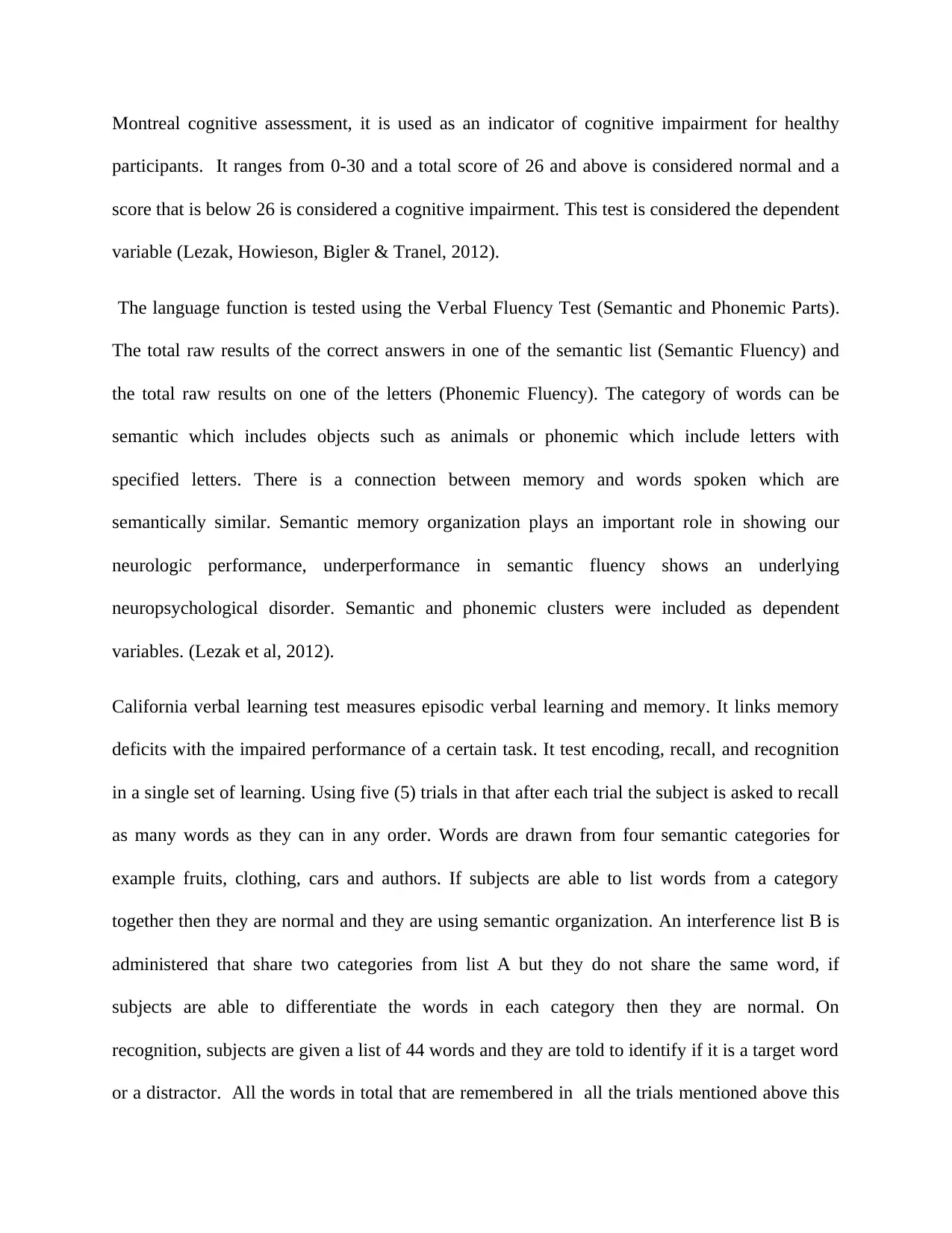
Montreal cognitive assessment, it is used as an indicator of cognitive impairment for healthy
participants. It ranges from 0-30 and a total score of 26 and above is considered normal and a
score that is below 26 is considered a cognitive impairment. This test is considered the dependent
variable (Lezak, Howieson, Bigler & Tranel, 2012).
The language function is tested using the Verbal Fluency Test (Semantic and Phonemic Parts).
The total raw results of the correct answers in one of the semantic list (Semantic Fluency) and
the total raw results on one of the letters (Phonemic Fluency). The category of words can be
semantic which includes objects such as animals or phonemic which include letters with
specified letters. There is a connection between memory and words spoken which are
semantically similar. Semantic memory organization plays an important role in showing our
neurologic performance, underperformance in semantic fluency shows an underlying
neuropsychological disorder. Semantic and phonemic clusters were included as dependent
variables. (Lezak et al, 2012).
California verbal learning test measures episodic verbal learning and memory. It links memory
deficits with the impaired performance of a certain task. It test encoding, recall, and recognition
in a single set of learning. Using five (5) trials in that after each trial the subject is asked to recall
as many words as they can in any order. Words are drawn from four semantic categories for
example fruits, clothing, cars and authors. If subjects are able to list words from a category
together then they are normal and they are using semantic organization. An interference list B is
administered that share two categories from list A but they do not share the same word, if
subjects are able to differentiate the words in each category then they are normal. On
recognition, subjects are given a list of 44 words and they are told to identify if it is a target word
or a distractor. All the words in total that are remembered in all the trials mentioned above this
participants. It ranges from 0-30 and a total score of 26 and above is considered normal and a
score that is below 26 is considered a cognitive impairment. This test is considered the dependent
variable (Lezak, Howieson, Bigler & Tranel, 2012).
The language function is tested using the Verbal Fluency Test (Semantic and Phonemic Parts).
The total raw results of the correct answers in one of the semantic list (Semantic Fluency) and
the total raw results on one of the letters (Phonemic Fluency). The category of words can be
semantic which includes objects such as animals or phonemic which include letters with
specified letters. There is a connection between memory and words spoken which are
semantically similar. Semantic memory organization plays an important role in showing our
neurologic performance, underperformance in semantic fluency shows an underlying
neuropsychological disorder. Semantic and phonemic clusters were included as dependent
variables. (Lezak et al, 2012).
California verbal learning test measures episodic verbal learning and memory. It links memory
deficits with the impaired performance of a certain task. It test encoding, recall, and recognition
in a single set of learning. Using five (5) trials in that after each trial the subject is asked to recall
as many words as they can in any order. Words are drawn from four semantic categories for
example fruits, clothing, cars and authors. If subjects are able to list words from a category
together then they are normal and they are using semantic organization. An interference list B is
administered that share two categories from list A but they do not share the same word, if
subjects are able to differentiate the words in each category then they are normal. On
recognition, subjects are given a list of 44 words and they are told to identify if it is a target word
or a distractor. All the words in total that are remembered in all the trials mentioned above this

include the sum of semantic clusters in each of 1-5 learning trials and the free recall trials and
also the total number of true and false positives in recognition were included as dependent
variables derived from this test (Facal et al, 2016)
Delay recall trials and recognition test, test immediate recall, delay recall Recognition. Subjects
are told to learn some shapes or symbols before they are requested recall with a set time that is 3
minutes. This test helps detect any visual abilities and visual memory. the total number of true
and false positives in recognition were added as dependent variables (Lezak, Howieson, Bigler &
Tranel, 2012).
Visual attention and task switching are tested using the Trail Making Test in a span of 5 minutes
while Rey osterrieth complex figure test takes 5minutes. It has two parts, Test consists of 25
circles distributed over a sheet of paper where the circles are numbered 1 – 25, and the patient
should connect the numbers with lines in ascending order as quickly as possible while still
maintaining accuracy, time used taken to complete the test will be used as the performance
metric. Digit span test modalities can be backward or forward, the subject is given a list of items
and is requested to repeat them back in the correct order while forward digit is the opposite, the
subject will list items going forward and it is scored. Digits pan test evaluate persons cognitive
status and therefore were considered as dependent variables (Lezak, Howieson, Bigler & Tranel,
2012).
New learning and working memory are tested using Letter number sequencing. The subject will
be given a list of words and requested to list the first numerical numbers in the correct order and
then letters in alphabetical order. Depended variables were included that is Digit Backward total
also the total number of true and false positives in recognition were included as dependent
variables derived from this test (Facal et al, 2016)
Delay recall trials and recognition test, test immediate recall, delay recall Recognition. Subjects
are told to learn some shapes or symbols before they are requested recall with a set time that is 3
minutes. This test helps detect any visual abilities and visual memory. the total number of true
and false positives in recognition were added as dependent variables (Lezak, Howieson, Bigler &
Tranel, 2012).
Visual attention and task switching are tested using the Trail Making Test in a span of 5 minutes
while Rey osterrieth complex figure test takes 5minutes. It has two parts, Test consists of 25
circles distributed over a sheet of paper where the circles are numbered 1 – 25, and the patient
should connect the numbers with lines in ascending order as quickly as possible while still
maintaining accuracy, time used taken to complete the test will be used as the performance
metric. Digit span test modalities can be backward or forward, the subject is given a list of items
and is requested to repeat them back in the correct order while forward digit is the opposite, the
subject will list items going forward and it is scored. Digits pan test evaluate persons cognitive
status and therefore were considered as dependent variables (Lezak, Howieson, Bigler & Tranel,
2012).
New learning and working memory are tested using Letter number sequencing. The subject will
be given a list of words and requested to list the first numerical numbers in the correct order and
then letters in alphabetical order. Depended variables were included that is Digit Backward total

raw score from Digit Span Test and Trail Making Test Part B (Lezak, Howieson, Bigler &
Tranel, 2012).
Procedure
The methods that were used in this study was approved by the Local Institutional Review Board
and the consent was given to all authors of the articles and any study participant if required. It is
important to include medical history when carrying out blood pressure monitoring which has
been already been done an echocardiogram (Townsend et al, 2016). Participants should be given
the written consent form and all the task to be done this will ensure that information will be
utilized appropriately. All the information will be kept in an anonymous and confidential way.
Participants must be aware of their right to withdraw from taking part in the research any time
even during the study procedure.
Ethical
Ethical clearance has been sought from the university research committee and the respondents
who have been interviewed met the inclusion criteria and agreed to participate upon
consentingImportant principles of Human research ethics will adhere to and included; respect for
persons, beneficence, and justice. Respondents were comprehensively told about the objectives
of the study and thereafter requested to participate. It was emphasized that their involvement was
entirely voluntary and that they may withdraw at any time since there would be no punishment
resulting from non-participation They also had to be aware of their right to opt out at any time
and consult a psychologist from CITY's Counseling center. All participants are expected to fill a
consent form and no personal details were written in the questionnaire. Participants were told
Tranel, 2012).
Procedure
The methods that were used in this study was approved by the Local Institutional Review Board
and the consent was given to all authors of the articles and any study participant if required. It is
important to include medical history when carrying out blood pressure monitoring which has
been already been done an echocardiogram (Townsend et al, 2016). Participants should be given
the written consent form and all the task to be done this will ensure that information will be
utilized appropriately. All the information will be kept in an anonymous and confidential way.
Participants must be aware of their right to withdraw from taking part in the research any time
even during the study procedure.
Ethical
Ethical clearance has been sought from the university research committee and the respondents
who have been interviewed met the inclusion criteria and agreed to participate upon
consentingImportant principles of Human research ethics will adhere to and included; respect for
persons, beneficence, and justice. Respondents were comprehensively told about the objectives
of the study and thereafter requested to participate. It was emphasized that their involvement was
entirely voluntary and that they may withdraw at any time since there would be no punishment
resulting from non-participation They also had to be aware of their right to opt out at any time
and consult a psychologist from CITY's Counseling center. All participants are expected to fill a
consent form and no personal details were written in the questionnaire. Participants were told
Secure Best Marks with AI Grader
Need help grading? Try our AI Grader for instant feedback on your assignments.
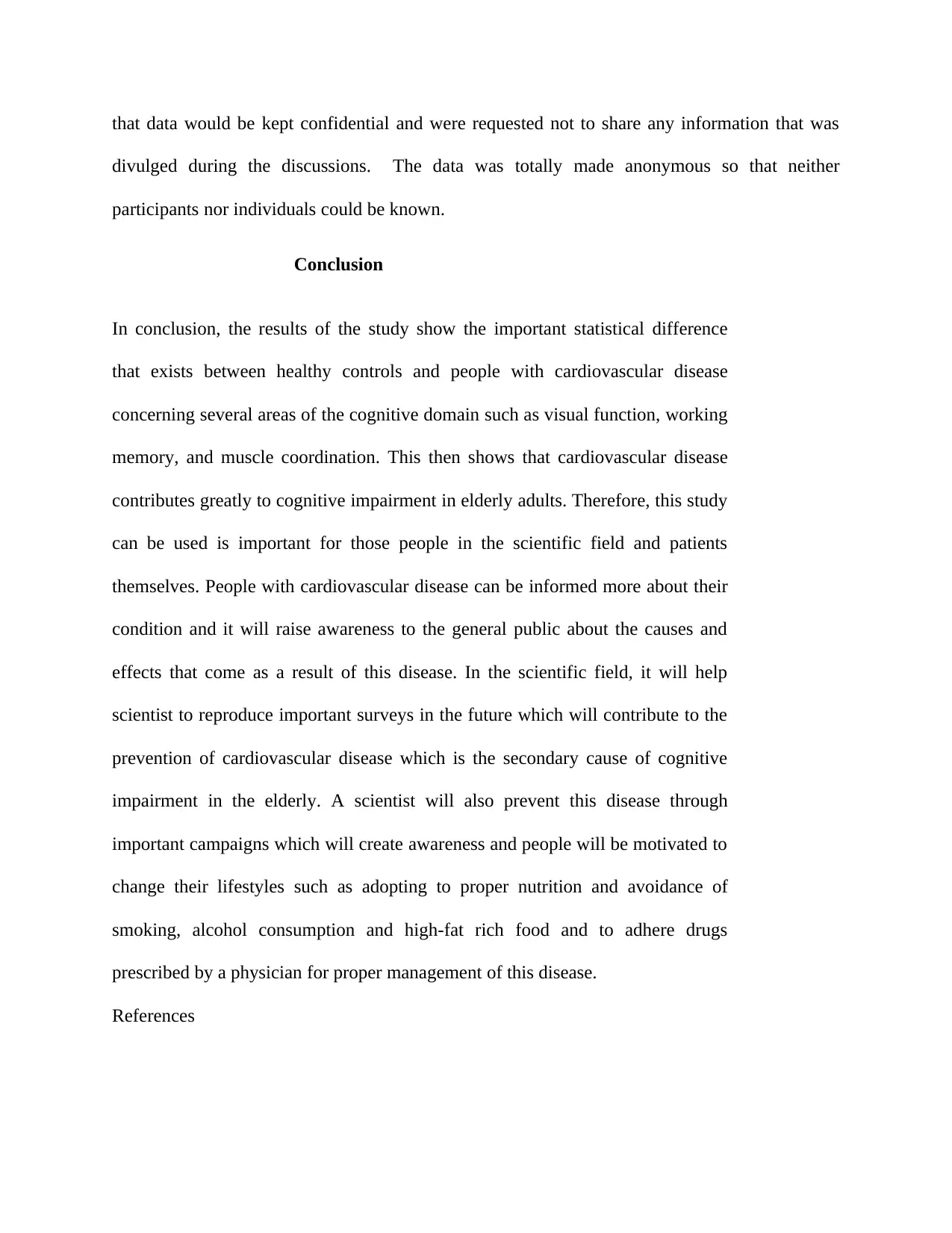
that data would be kept confidential and were requested not to share any information that was
divulged during the discussions. The data was totally made anonymous so that neither
participants nor individuals could be known.
Conclusion
In conclusion, the results of the study show the important statistical difference
that exists between healthy controls and people with cardiovascular disease
concerning several areas of the cognitive domain such as visual function, working
memory, and muscle coordination. This then shows that cardiovascular disease
contributes greatly to cognitive impairment in elderly adults. Therefore, this study
can be used is important for those people in the scientific field and patients
themselves. People with cardiovascular disease can be informed more about their
condition and it will raise awareness to the general public about the causes and
effects that come as a result of this disease. In the scientific field, it will help
scientist to reproduce important surveys in the future which will contribute to the
prevention of cardiovascular disease which is the secondary cause of cognitive
impairment in the elderly. A scientist will also prevent this disease through
important campaigns which will create awareness and people will be motivated to
change their lifestyles such as adopting to proper nutrition and avoidance of
smoking, alcohol consumption and high-fat rich food and to adhere drugs
prescribed by a physician for proper management of this disease.
References
divulged during the discussions. The data was totally made anonymous so that neither
participants nor individuals could be known.
Conclusion
In conclusion, the results of the study show the important statistical difference
that exists between healthy controls and people with cardiovascular disease
concerning several areas of the cognitive domain such as visual function, working
memory, and muscle coordination. This then shows that cardiovascular disease
contributes greatly to cognitive impairment in elderly adults. Therefore, this study
can be used is important for those people in the scientific field and patients
themselves. People with cardiovascular disease can be informed more about their
condition and it will raise awareness to the general public about the causes and
effects that come as a result of this disease. In the scientific field, it will help
scientist to reproduce important surveys in the future which will contribute to the
prevention of cardiovascular disease which is the secondary cause of cognitive
impairment in the elderly. A scientist will also prevent this disease through
important campaigns which will create awareness and people will be motivated to
change their lifestyles such as adopting to proper nutrition and avoidance of
smoking, alcohol consumption and high-fat rich food and to adhere drugs
prescribed by a physician for proper management of this disease.
References
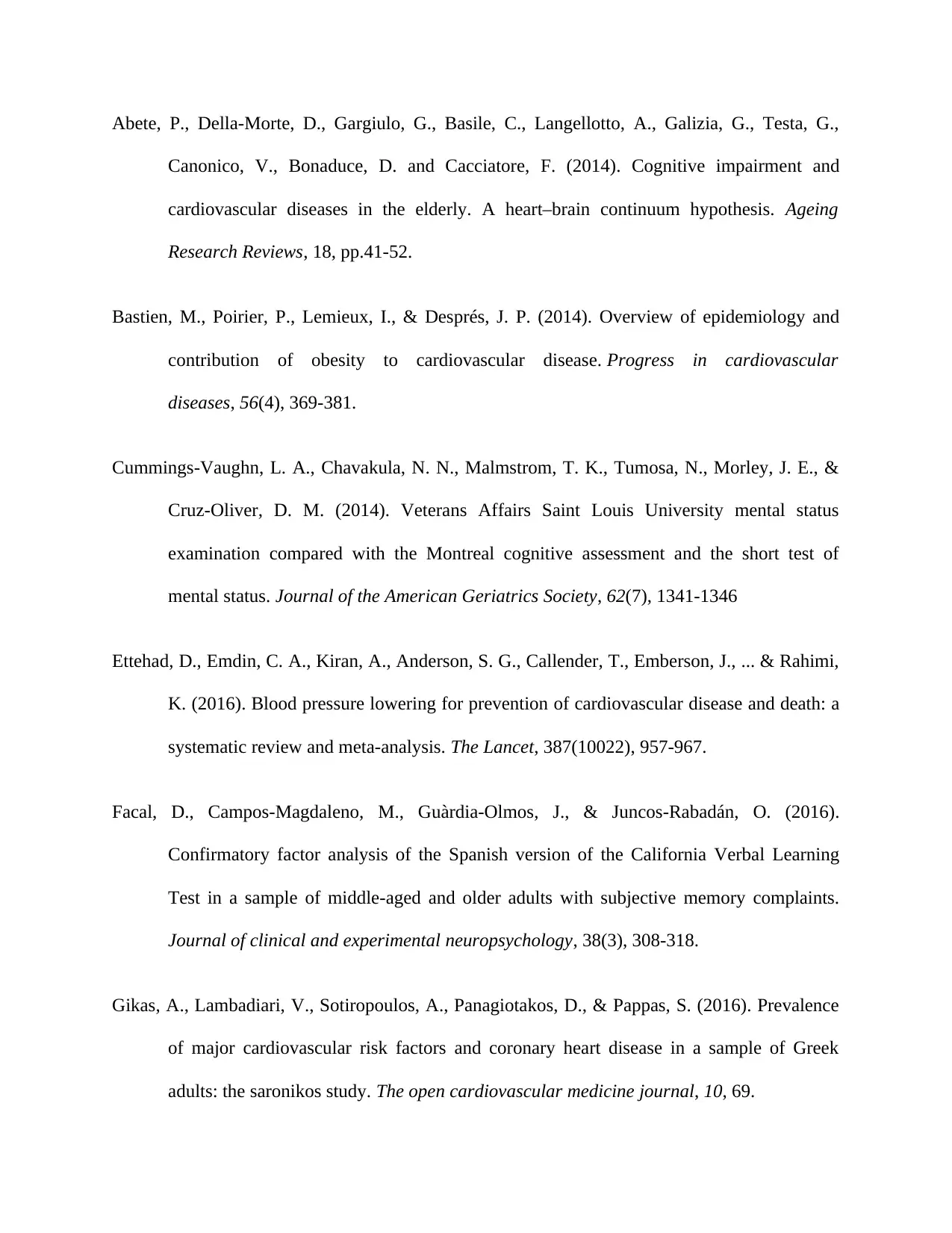
Abete, P., Della-Morte, D., Gargiulo, G., Basile, C., Langellotto, A., Galizia, G., Testa, G.,
Canonico, V., Bonaduce, D. and Cacciatore, F. (2014). Cognitive impairment and
cardiovascular diseases in the elderly. A heart–brain continuum hypothesis. Ageing
Research Reviews, 18, pp.41-52.
Bastien, M., Poirier, P., Lemieux, I., & Després, J. P. (2014). Overview of epidemiology and
contribution of obesity to cardiovascular disease. Progress in cardiovascular
diseases, 56(4), 369-381.
Cummings‐Vaughn, L. A., Chavakula, N. N., Malmstrom, T. K., Tumosa, N., Morley, J. E., &
Cruz‐Oliver, D. M. (2014). Veterans Affairs Saint Louis University mental status
examination compared with the Montreal cognitive assessment and the short test of
mental status. Journal of the American Geriatrics Society, 62(7), 1341-1346
Ettehad, D., Emdin, C. A., Kiran, A., Anderson, S. G., Callender, T., Emberson, J., ... & Rahimi,
K. (2016). Blood pressure lowering for prevention of cardiovascular disease and death: a
systematic review and meta-analysis. The Lancet, 387(10022), 957-967.
Facal, D., Campos-Magdaleno, M., Guàrdia-Olmos, J., & Juncos-Rabadán, O. (2016).
Confirmatory factor analysis of the Spanish version of the California Verbal Learning
Test in a sample of middle-aged and older adults with subjective memory complaints.
Journal of clinical and experimental neuropsychology, 38(3), 308-318.
Gikas, A., Lambadiari, V., Sotiropoulos, A., Panagiotakos, D., & Pappas, S. (2016). Prevalence
of major cardiovascular risk factors and coronary heart disease in a sample of Greek
adults: the saronikos study. The open cardiovascular medicine journal, 10, 69.
Canonico, V., Bonaduce, D. and Cacciatore, F. (2014). Cognitive impairment and
cardiovascular diseases in the elderly. A heart–brain continuum hypothesis. Ageing
Research Reviews, 18, pp.41-52.
Bastien, M., Poirier, P., Lemieux, I., & Després, J. P. (2014). Overview of epidemiology and
contribution of obesity to cardiovascular disease. Progress in cardiovascular
diseases, 56(4), 369-381.
Cummings‐Vaughn, L. A., Chavakula, N. N., Malmstrom, T. K., Tumosa, N., Morley, J. E., &
Cruz‐Oliver, D. M. (2014). Veterans Affairs Saint Louis University mental status
examination compared with the Montreal cognitive assessment and the short test of
mental status. Journal of the American Geriatrics Society, 62(7), 1341-1346
Ettehad, D., Emdin, C. A., Kiran, A., Anderson, S. G., Callender, T., Emberson, J., ... & Rahimi,
K. (2016). Blood pressure lowering for prevention of cardiovascular disease and death: a
systematic review and meta-analysis. The Lancet, 387(10022), 957-967.
Facal, D., Campos-Magdaleno, M., Guàrdia-Olmos, J., & Juncos-Rabadán, O. (2016).
Confirmatory factor analysis of the Spanish version of the California Verbal Learning
Test in a sample of middle-aged and older adults with subjective memory complaints.
Journal of clinical and experimental neuropsychology, 38(3), 308-318.
Gikas, A., Lambadiari, V., Sotiropoulos, A., Panagiotakos, D., & Pappas, S. (2016). Prevalence
of major cardiovascular risk factors and coronary heart disease in a sample of Greek
adults: the saronikos study. The open cardiovascular medicine journal, 10, 69.
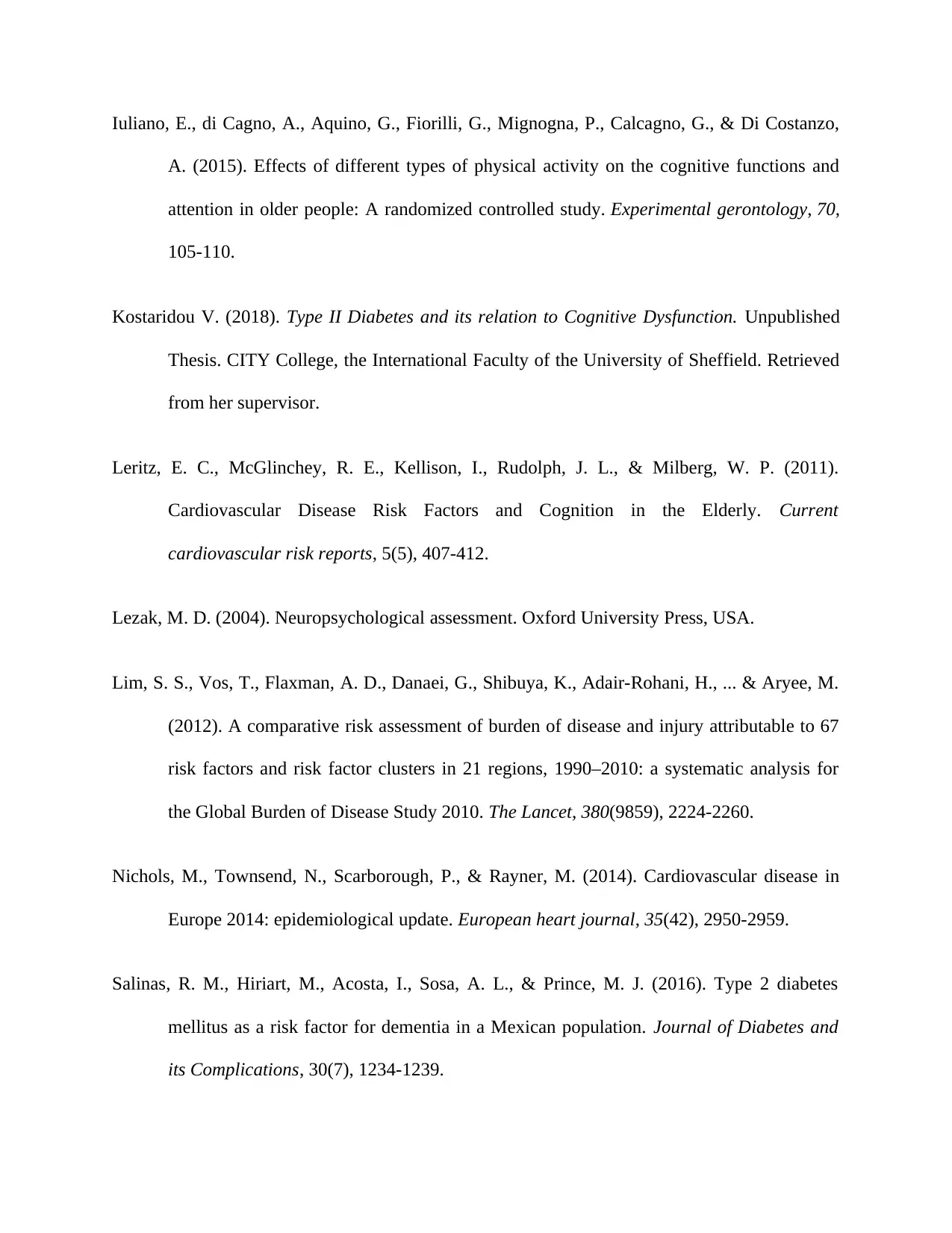
Iuliano, E., di Cagno, A., Aquino, G., Fiorilli, G., Mignogna, P., Calcagno, G., & Di Costanzo,
A. (2015). Effects of different types of physical activity on the cognitive functions and
attention in older people: A randomized controlled study. Experimental gerontology, 70,
105-110.
Kostaridou V. (2018). Type II Diabetes and its relation to Cognitive Dysfunction. Unpublished
Thesis. CITY College, the International Faculty of the University of Sheffield. Retrieved
from her supervisor.
Leritz, E. C., McGlinchey, R. E., Kellison, I., Rudolph, J. L., & Milberg, W. P. (2011).
Cardiovascular Disease Risk Factors and Cognition in the Elderly. Current
cardiovascular risk reports, 5(5), 407-412.
Lezak, M. D. (2004). Neuropsychological assessment. Oxford University Press, USA.
Lim, S. S., Vos, T., Flaxman, A. D., Danaei, G., Shibuya, K., Adair-Rohani, H., ... & Aryee, M.
(2012). A comparative risk assessment of burden of disease and injury attributable to 67
risk factors and risk factor clusters in 21 regions, 1990–2010: a systematic analysis for
the Global Burden of Disease Study 2010. The Lancet, 380(9859), 2224-2260.
Nichols, M., Townsend, N., Scarborough, P., & Rayner, M. (2014). Cardiovascular disease in
Europe 2014: epidemiological update. European heart journal, 35(42), 2950-2959.
Salinas, R. M., Hiriart, M., Acosta, I., Sosa, A. L., & Prince, M. J. (2016). Type 2 diabetes
mellitus as a risk factor for dementia in a Mexican population. Journal of Diabetes and
its Complications, 30(7), 1234-1239.
A. (2015). Effects of different types of physical activity on the cognitive functions and
attention in older people: A randomized controlled study. Experimental gerontology, 70,
105-110.
Kostaridou V. (2018). Type II Diabetes and its relation to Cognitive Dysfunction. Unpublished
Thesis. CITY College, the International Faculty of the University of Sheffield. Retrieved
from her supervisor.
Leritz, E. C., McGlinchey, R. E., Kellison, I., Rudolph, J. L., & Milberg, W. P. (2011).
Cardiovascular Disease Risk Factors and Cognition in the Elderly. Current
cardiovascular risk reports, 5(5), 407-412.
Lezak, M. D. (2004). Neuropsychological assessment. Oxford University Press, USA.
Lim, S. S., Vos, T., Flaxman, A. D., Danaei, G., Shibuya, K., Adair-Rohani, H., ... & Aryee, M.
(2012). A comparative risk assessment of burden of disease and injury attributable to 67
risk factors and risk factor clusters in 21 regions, 1990–2010: a systematic analysis for
the Global Burden of Disease Study 2010. The Lancet, 380(9859), 2224-2260.
Nichols, M., Townsend, N., Scarborough, P., & Rayner, M. (2014). Cardiovascular disease in
Europe 2014: epidemiological update. European heart journal, 35(42), 2950-2959.
Salinas, R. M., Hiriart, M., Acosta, I., Sosa, A. L., & Prince, M. J. (2016). Type 2 diabetes
mellitus as a risk factor for dementia in a Mexican population. Journal of Diabetes and
its Complications, 30(7), 1234-1239.
Paraphrase This Document
Need a fresh take? Get an instant paraphrase of this document with our AI Paraphraser
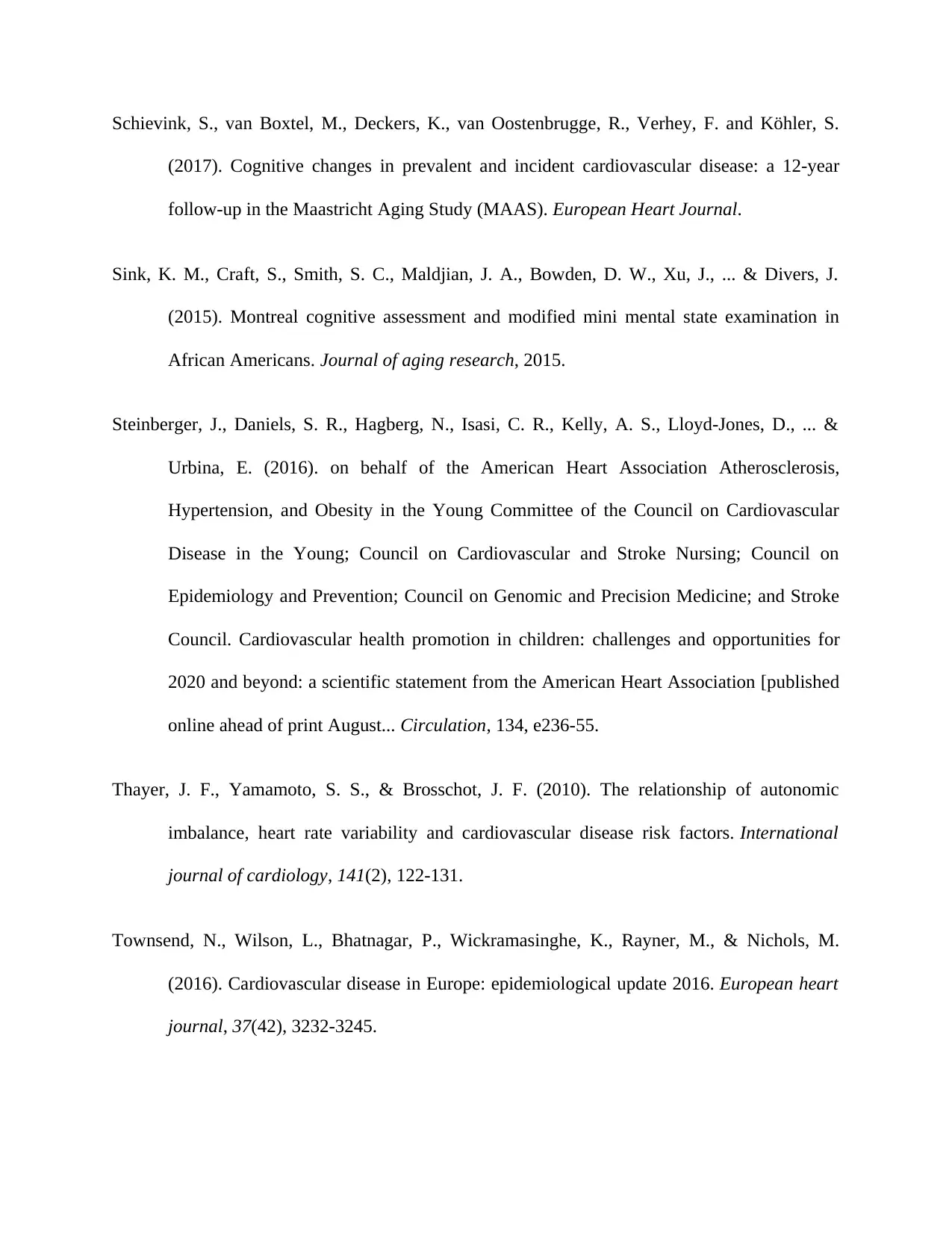
Schievink, S., van Boxtel, M., Deckers, K., van Oostenbrugge, R., Verhey, F. and Köhler, S.
(2017). Cognitive changes in prevalent and incident cardiovascular disease: a 12-year
follow-up in the Maastricht Aging Study (MAAS). European Heart Journal.
Sink, K. M., Craft, S., Smith, S. C., Maldjian, J. A., Bowden, D. W., Xu, J., ... & Divers, J.
(2015). Montreal cognitive assessment and modified mini mental state examination in
African Americans. Journal of aging research, 2015.
Steinberger, J., Daniels, S. R., Hagberg, N., Isasi, C. R., Kelly, A. S., Lloyd-Jones, D., ... &
Urbina, E. (2016). on behalf of the American Heart Association Atherosclerosis,
Hypertension, and Obesity in the Young Committee of the Council on Cardiovascular
Disease in the Young; Council on Cardiovascular and Stroke Nursing; Council on
Epidemiology and Prevention; Council on Genomic and Precision Medicine; and Stroke
Council. Cardiovascular health promotion in children: challenges and opportunities for
2020 and beyond: a scientific statement from the American Heart Association [published
online ahead of print August... Circulation, 134, e236-55.
Thayer, J. F., Yamamoto, S. S., & Brosschot, J. F. (2010). The relationship of autonomic
imbalance, heart rate variability and cardiovascular disease risk factors. International
journal of cardiology, 141(2), 122-131.
Townsend, N., Wilson, L., Bhatnagar, P., Wickramasinghe, K., Rayner, M., & Nichols, M.
(2016). Cardiovascular disease in Europe: epidemiological update 2016. European heart
journal, 37(42), 3232-3245.
(2017). Cognitive changes in prevalent and incident cardiovascular disease: a 12-year
follow-up in the Maastricht Aging Study (MAAS). European Heart Journal.
Sink, K. M., Craft, S., Smith, S. C., Maldjian, J. A., Bowden, D. W., Xu, J., ... & Divers, J.
(2015). Montreal cognitive assessment and modified mini mental state examination in
African Americans. Journal of aging research, 2015.
Steinberger, J., Daniels, S. R., Hagberg, N., Isasi, C. R., Kelly, A. S., Lloyd-Jones, D., ... &
Urbina, E. (2016). on behalf of the American Heart Association Atherosclerosis,
Hypertension, and Obesity in the Young Committee of the Council on Cardiovascular
Disease in the Young; Council on Cardiovascular and Stroke Nursing; Council on
Epidemiology and Prevention; Council on Genomic and Precision Medicine; and Stroke
Council. Cardiovascular health promotion in children: challenges and opportunities for
2020 and beyond: a scientific statement from the American Heart Association [published
online ahead of print August... Circulation, 134, e236-55.
Thayer, J. F., Yamamoto, S. S., & Brosschot, J. F. (2010). The relationship of autonomic
imbalance, heart rate variability and cardiovascular disease risk factors. International
journal of cardiology, 141(2), 122-131.
Townsend, N., Wilson, L., Bhatnagar, P., Wickramasinghe, K., Rayner, M., & Nichols, M.
(2016). Cardiovascular disease in Europe: epidemiological update 2016. European heart
journal, 37(42), 3232-3245.
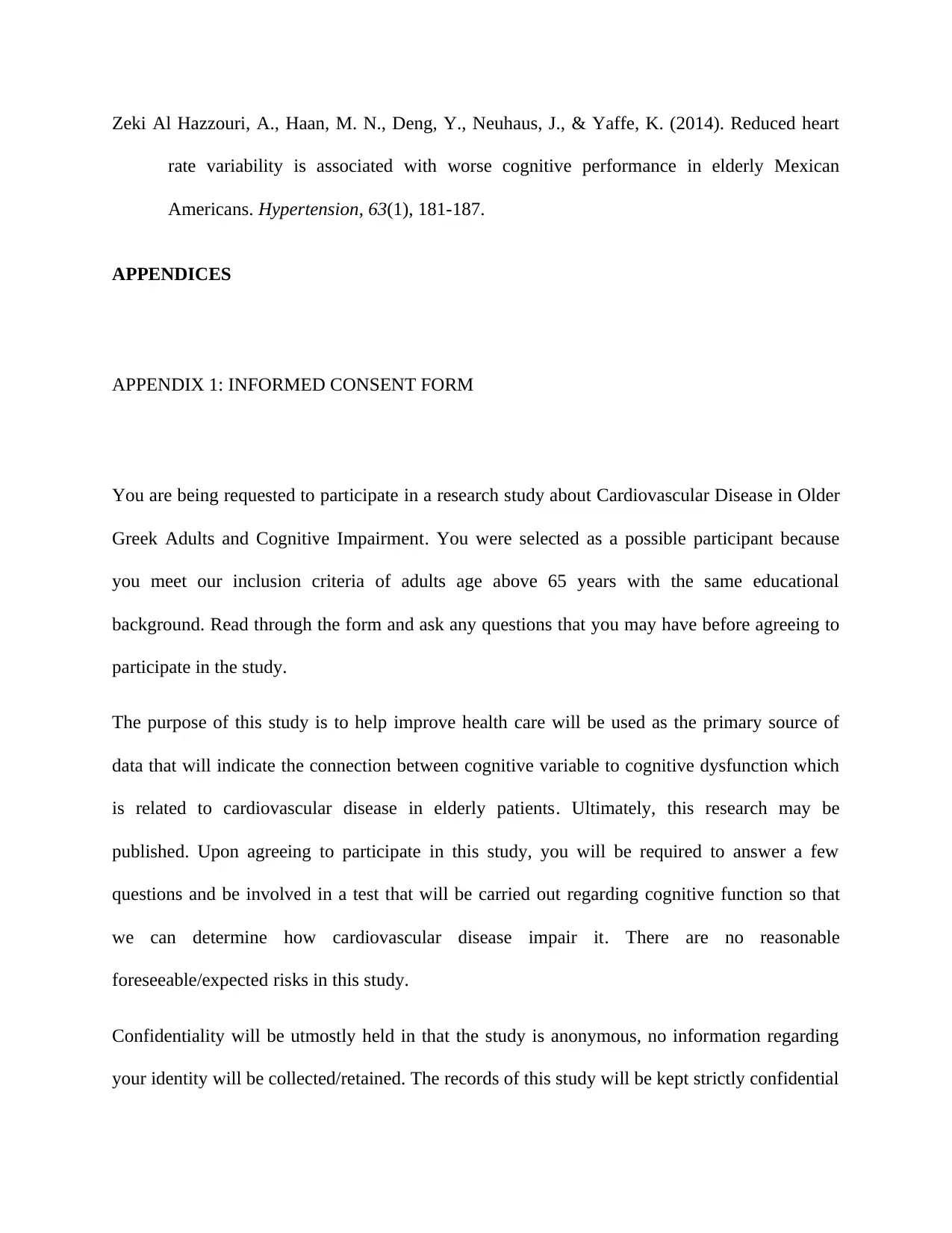
Zeki Al Hazzouri, A., Haan, M. N., Deng, Y., Neuhaus, J., & Yaffe, K. (2014). Reduced heart
rate variability is associated with worse cognitive performance in elderly Mexican
Americans. Hypertension, 63(1), 181-187.
APPENDICES
APPENDIX 1: INFORMED CONSENT FORM
You are being requested to participate in a research study about Cardiovascular Disease in Older
Greek Adults and Cognitive Impairment. You were selected as a possible participant because
you meet our inclusion criteria of adults age above 65 years with the same educational
background. Read through the form and ask any questions that you may have before agreeing to
participate in the study.
The purpose of this study is to help improve health care will be used as the primary source of
data that will indicate the connection between cognitive variable to cognitive dysfunction which
is related to cardiovascular disease in elderly patients. Ultimately, this research may be
published. Upon agreeing to participate in this study, you will be required to answer a few
questions and be involved in a test that will be carried out regarding cognitive function so that
we can determine how cardiovascular disease impair it. There are no reasonable
foreseeable/expected risks in this study.
Confidentiality will be utmostly held in that the study is anonymous, no information regarding
your identity will be collected/retained. The records of this study will be kept strictly confidential
rate variability is associated with worse cognitive performance in elderly Mexican
Americans. Hypertension, 63(1), 181-187.
APPENDICES
APPENDIX 1: INFORMED CONSENT FORM
You are being requested to participate in a research study about Cardiovascular Disease in Older
Greek Adults and Cognitive Impairment. You were selected as a possible participant because
you meet our inclusion criteria of adults age above 65 years with the same educational
background. Read through the form and ask any questions that you may have before agreeing to
participate in the study.
The purpose of this study is to help improve health care will be used as the primary source of
data that will indicate the connection between cognitive variable to cognitive dysfunction which
is related to cardiovascular disease in elderly patients. Ultimately, this research may be
published. Upon agreeing to participate in this study, you will be required to answer a few
questions and be involved in a test that will be carried out regarding cognitive function so that
we can determine how cardiovascular disease impair it. There are no reasonable
foreseeable/expected risks in this study.
Confidentiality will be utmostly held in that the study is anonymous, no information regarding
your identity will be collected/retained. The records of this study will be kept strictly confidential

and your identity will not be disclosed in the material published. The decision to participate in
the study is entirely upon you, you have the right to refuse participation or withdraw completely
from the interview at any point during the process. You also have the right to ask questions
before, during or after the study.
Your signature below indicates that you have decided to volunteer as a research participant for
this study and that you have read and understood the information provided above.
Subject’s signature……………. Investigator’s signature……………….
Signature……………….
Date…………………….. Date………………………
the study is entirely upon you, you have the right to refuse participation or withdraw completely
from the interview at any point during the process. You also have the right to ask questions
before, during or after the study.
Your signature below indicates that you have decided to volunteer as a research participant for
this study and that you have read and understood the information provided above.
Subject’s signature……………. Investigator’s signature……………….
Signature……………….
Date…………………….. Date………………………
Secure Best Marks with AI Grader
Need help grading? Try our AI Grader for instant feedback on your assignments.
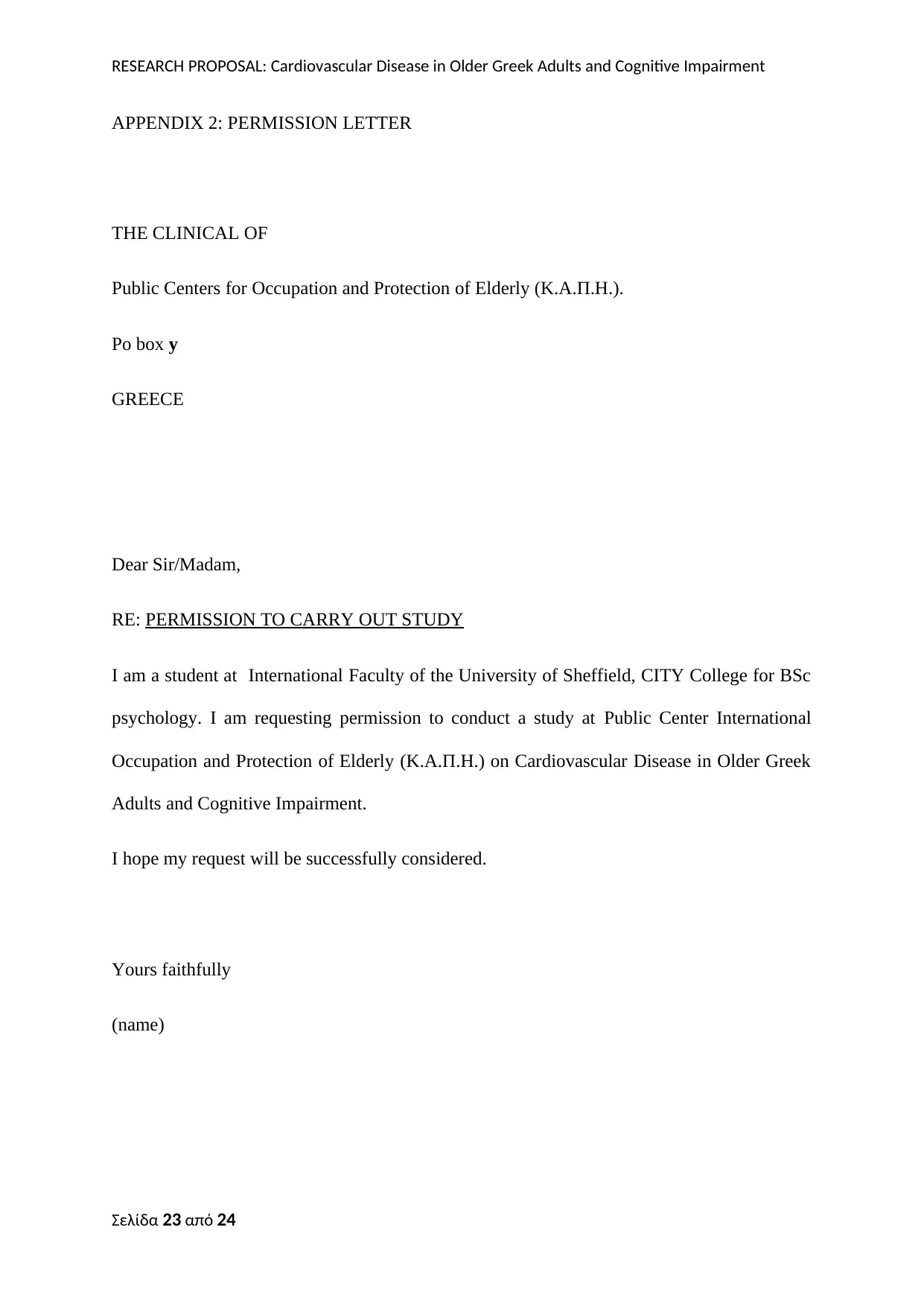
RESEARCH PROPOSAL: Cardiovascular Disease in Older Greek Adults and Cognitive Impairment
APPENDIX 2: PERMISSION LETTER
THE CLINICAL OF
Public Centers for Occupation and Protection of Elderly (Κ.Α.Π.Η.).
Po box y
GREECE
Dear Sir/Madam,
RE: PERMISSION TO CARRY OUT STUDY
I am a student at International Faculty of the University of Sheffield, CITY College for BSc
psychology. I am requesting permission to conduct a study at Public Center International
Occupation and Protection of Elderly (Κ.Α.Π.Η.) on Cardiovascular Disease in Older Greek
Adults and Cognitive Impairment.
I hope my request will be successfully considered.
Yours faithfully
(name)
Σελίδα 23 από 24
APPENDIX 2: PERMISSION LETTER
THE CLINICAL OF
Public Centers for Occupation and Protection of Elderly (Κ.Α.Π.Η.).
Po box y
GREECE
Dear Sir/Madam,
RE: PERMISSION TO CARRY OUT STUDY
I am a student at International Faculty of the University of Sheffield, CITY College for BSc
psychology. I am requesting permission to conduct a study at Public Center International
Occupation and Protection of Elderly (Κ.Α.Π.Η.) on Cardiovascular Disease in Older Greek
Adults and Cognitive Impairment.
I hope my request will be successfully considered.
Yours faithfully
(name)
Σελίδα 23 από 24

RESEARCH PROPOSAL: Cardiovascular Disease in Older Greek Adults and Cognitive Impairment
Σελίδα 24 από 24
Σελίδα 24 από 24
1 out of 24
Related Documents
Your All-in-One AI-Powered Toolkit for Academic Success.
+13062052269
info@desklib.com
Available 24*7 on WhatsApp / Email
![[object Object]](/_next/static/media/star-bottom.7253800d.svg)
Unlock your academic potential
© 2024 | Zucol Services PVT LTD | All rights reserved.





